
How to Say ‘a Lot’ in Italian

In Italian there are a variety of ways to say ‘a lot’ and ‘many’. How would you say, for example, ‘there are a lot of beautiful churches in Italy’ or ‘there are so many good wines in Italy’? In grammar terms these are called quantifiers and it’s useful to be able to use them correctly in Italian.
You probably already know ‘molto’ (many) and tanto (so many) which can be used as both adjectives and adverbs. When they’re used as adjectives they have to agree in gender and number with the thing they describe. When they’re used as adverbs they don’t need to change.
Let’s look at some examples:
Ho speso molti soldi al mercato - I spent a lot of money at the market (adjective)
Ci sono molte scarpe belle qui - There are a lot of beautiful shoes here / There are many beautiful shoes here (adjective)
Ho visto tanti libri nuovi in libreria - I saw so many new books in the book shop (adjective)
I bimbi hanno mangiato tante torte - The children ate so many cakes (adjective)
La pizza è molto buona - The pizza is really nice (adverb)
Ieri ho lavorato tanto - Yesterday I worked a lot / Yesterday I worked so much (adverb)
Gli studenti sono bravi, studiano molto - The students are good, they study a lot (adverb)
Mi sono divertita tanto alla festa ieri - I had so much fun at the party yesterday / I enjoyed myself a lot at the party yesterday
There are some other, more informal, expressions we can use to express: a lot, so much, many - let’s have a look!
Parecchio (‘quite a lot’ or ‘quite a bit’)
Vi aspettiamo da parecchio tempo - We have been waiting for you for quite some time
Abbiamo bevuto parecchio! - We drank quite a bit!
Piangeva parecchio - He was crying quite a lot
Abbiamo ballato parecchio in discoteca - We danced quite a lot at the club
Un bel po’ (‘quite a lot’)
C’è ancora un bel po’ di pasta nella pentola - There’s quite a lot of pasta left in the pot
Sono stata in un bel po’ di posti in Italy - I have been to quite a few places in Italy
Hanno speso un bel po’ per quella casa - They really spent quite a lot on that house
Un bel po’ di gente viene all’evento - Quite a lot of people are coming to the event
Un sacco (literally ‘a sack’ or ‘a bag’)
Ho ricevuto un sacco di messaggini - I received lots of / a load of / so many messages
C’era un sacco di gente alla mostra - There were lots of people at the party
Abbiamo mangiato un sacco questo fine settimana - We ate so much this weekend
Mi piace un sacco questa birra - I really like this beer
Abbiamo camminato un sacco ieri - We walked so much yesterday
Un mucchio (literally ‘a heap’ or ‘a pile’)
C’è un mucchio di lavoro da fare - There’s a heap of work left to do
Ho speso un mucchio di soldi ieri - I spent a load of money yesterday
Ora abbiamo un mucchio di problemi - Now we have so many problems
You may also be interested in...

Latest property in Italy

What to do in Italy
Enjoying this Italy intel? You might also love:


(by DuoItalian)
This lesson provides some basic vocabulary on means of transportation in Italian, which might be useful for a trip to Italy. Also included are some basic introduction sentences.
- Di dove sei? (Where are you from?)
- Sono italiano, di Milano. (I am Italian, from Milan.)
- Roberto è spagnolo, di Madrid. (Robert is Spanish, from Madrid.)
TIP : The Italian adjective straniero (foreign) can also be used as a noun ( il straniero meaning “foreigner”)
For additional information, visit the DuoItalian page on Travel Phrases .
(from Duolingo)
Study and Test Yourself
Leave A Comment Cancel reply
You must be logged in to post a comment.

Do you need an Italian Dictionary Online? – Take a look at the Duolingo Dictionary
Do you need an Italian Dictionary Online? I have discovered a handy Italian dictionary and wanted to share it with all of you. Have you heard about Duolingo before? Yeah, I’m pretty sure you have! Duolingo also has a place to look up the words you do not know. And it’s completely free.
Have you heard of Duolingo?
Most of us have started learning Italian online using Duolingo. If you haven’t tried it yet, click here to see what I’m talking about (it’s free too).
But in this article, we won’t talk about Duolingo’s Italian course. We’re here to talk about the Duolingo Dictionary.
It’s an English-Italian and Italian-English dictionary. That means you can write words in Italian and see their translation in English. But you can also write in English and get the translation in Italian.
On the other hand, we must also state that the platform focuses on native English speakers wanting to learn Italian. So, Italians learning English may have difficulty using the platform.
If you want to go over and check out this Duolingo Dictionary for yourself, click here or the banner below.

Languages supported by the Duolingo Dictionary
Besides Italian, you can also use the Duolingo Dictionary if you’re searching for words in Czech, Welsh, Danish, German, Greek, Esperanto, Spanish, French, Irish, Hebrew, Hindi, Hungarian, High Valyrian (yes, the one you hear in Game of Thrones), Hawaiian, Indonesian, Japanese, Korean, Dutch, Norwegian (Bokmâl), Navajo, Polish, Portuguese, Russian, Swedish, Swahili, Klingon (this one is a language spoken in the Star Trek universe, so you better learn this language before going out to space), Turkish, Ukrainian, Vietnamese and Chinese.

I know you’ll want to go over and see how you write “dragon” in High Valyrian or “Earth” in Klingon. Come on, give it a try!

Looking for an Italian Dictionary Online? Here is what I like about Duolingo Dictionary
However, you may say: “What makes this dictionary special? Up to this point, every time I don’t understand a word, I go over to Google Translator.” So let’s dive deeper into Duolingo’s dictionary to see what makes it so cool.
I’ll share with you a few searches I have done. Sorry, only words in Italian and English. You’ll have to search for yourself if you want High Valyrian or Klingon, LOL.
Let’s look up some words in the Duolingo Dictionary!
Nothing gives us a closer experience with a product than opening it up and looking at it. So here we’ll open Duolingo Dictionary and perform a few searches.
Searching for the word Re in the Duolingo Dictionary
Let’s start with a couple of Italian words. We’ll search for the word “ Re ” which means king in Italian. Here are the results.

Right after you perform the search, you can listen to its pronunciation. You have the translation. But there are also several examples displayed.
These examples show the word in action for masculine and feminine. They also present plural and singular, and so on. For some words, the list of showcases is lengthy.
At the bottom of the results for “ Re ,” Duolingo also provides a list of words that could relate to the word we searched.
Searching for the word Mangia in the Duolingo Dictionary
Now let’s search for a popular word in Italy: “ Mangia .” Italy is also known as Eataly for its delicious food. Have you checked out the free Italian course about a mysterious case involving an Italian recipe? Click here to take a look at it. By the way, “ Mangia ” means eat in Italian.

The results here are even more extensive than for “ Re ” (king in Italian). Duolingo Dictionary helps us with lots of examples and conjugations. Conjugations in the present, remote past, and future include indicative, subjunctive, and others. There are also a few related words to the term “ Mangia .”
Searching for the word Flag in the Duolingo Dictionary
Let’s end this post by searching for the English word “Flag.” In Italian, the term is “ Bandiera .” And again, the thing I like the most about this dictionary are the examples. For this search, the example reads: “The Italian flag is green, white, and red.”

Now it’s your turn to search for a word. Do you know what “ vero ” means in Italian? I hear you saying: “Ahh, that one’s easy! No need to check that one. Vero is short for Veronica.” If you said that, then you must really check what “ vero ” means.
I have this dictionary bookmarked. When I’m reading, and something hard to understand pops up, I check Duolingo’s dictionary.

I encourage you to give it a try and bookmark it too.
Let me hear from you. What do you think about this dictionary?
Similar Posts

Italian Dictionary for kids
An Italian dictionary for kids must have at least one thing. Pictures! That’s for sure! Don’t we get disappointed when we’re expecting a book to have pictures and find out it hasn’t (even us being adults)? Recently I heard of somebody that received a cookbook and… no pictures. She said that pictures in a cookbook…

Learn the basic Italian
Where do you start when you’re learning Italian? The basics? There are a lot of people who get their foot in the door with a language and then quit (me included). Why do we jump off the language-learning train? The most common answers are because of feeling disappointed, tired, or unmotivated. Based on our own…

It’s fun to learn Italian reading folktales
An excellent way to advance your Italian is to keep on reading in this language. It is great fun to learn Italian reading folktales. The process of learning a Language Language learning involves the development of receptive and productive skills. Reading and listening are receptive skills, whereas writing and speaking are productive. One thing that…

Short Italian folktales – The Griffin’s Feather
From the numerous short Italian folktales, we have selected this very interesting fable from the northwest region of Italy called Piedmont. The name Piedmont means “at the foot of the mountains”. And this is one of the major characteristics of this region; it’s surrounded on three sides by the Alps. This includes Monviso (where the…

Basic Italian for children
When we try to pack up a set of lessons with the label “Italian for children,” we encounter several challenges. First of all, a child’s attention span is shorter than an adult’s. And their background is also quite limited. But if we manage to engage them, we will convert them into devoted learners. Italian for…

Tinycards by Duolingo – Flashcards for learning languages
Anybody following my site for some time knows my main goal. And it’s to bring you all the good resources for learning languages online. Thus, I’m glad to share that many of them are free! And this is the case for Tinycards by Duolingo. You have probably used flashcards before to memorize things. And have…
42 Comments
This sounds like a really useful and inventive tool! Like you mention in your article, I found myself wondering, “what makes this better than Google translator?” (which I use a lot living here in Costa Rica and not being a native Spanish speaker). I really like the feature of being able to listen to a word’s translation after you look it up and understand its meaning. And I also like the extensive list of examples that this dictionary delivers for each word we look up.
Pretty clever of them to include a couple “non-earthly” languages in their collection as well!
Yes, there are a couple of things that make Duolingo Dictionary a nice complement of Google translator. Besides the actual translation and audio, the list of examples delivered for each word we search make it very useful. Thank you very much for stopping by and for your comment.
You traveled to Costa Rica and Google translator and Duolingo Dictionary can translate for you. But if you decide to take a trip to the outer space, only Duolingo Dictionary can give you a hand. Enjoy your time in Costa Rica! 🙂
Awesome article, I loved the reading!
One of my dreams is to learn Italian. I just love this language. Most of my friends were Italian, and they taught me only one sentence, which is “fermati perché inizi a arrabbiarti” I would love to learn more phrases. Just a question, please. How long do you think it will take to learn Italian? How many minutes per day would you suggest? Do you think audio is better than reading?
Sorry for all these questions, but I couldn’t help it 🙂
Thank you for this excellent post!
Hi Daniella! It’s wonderful to hear your experience with Italian has been very pleasant. And I encourage you to learn Italian. I personally believe you should just start… and if you are using the right resources, courses and platforms that click with you, the rest will be as pleasant as your experience with the language so far. Concerning your questions: How long it takes to learn Italian? I must state that you already speak English, and there is common ground (not as much as with Spanish or French, but you’re in advantage compared to Chinese, Japanese and many others). Setting a time frame is difficult but once you click with the language, you’ve made it! I’d give it a try for six months. Do you think audio is better than reading? This is a very good question and I believe the answer depends on what you want to archive or what you enjoy most. I personally love to listen. And listening to people talking in Italian all day would be an excellent start even if the first days you don’t understand a word. You’ll find this post interesting, click here. How many minutes per day would you suggest? You’ll probably be surprised with me, but give it a try with 5 minutes per day! I can recommend you a platform that’s really fun, it’s free and super useful. Click here to start with your first 5 minutes today! 🙂
This is one of the best informative articles I have ever read. You should always have a dictionary at hand. It is the most useful tool. And I perceive this Duolingo Dictionary is clear, easy to understand and complete. I had been looking for a dictionary like this one.
The examples are very useful. I have performed a couple of searches myself and am really impressed with the results.
PD: I even searched for words in Klingon. You know, one never knows. LOL.
Hi! Thank you very much for your nice words concerning this post. I’m glad you found value in it. Yes, Duolingo Dictionary is a good dictionary. And I am thrilled to hear you have started using it already. Cool you began searching for Italian words and ended up looking for words in Klingon. LOL
Learning a new language is always interesting. However, it can be difficult especially if you do not live among the native speakers of this language.
I know of the Duolingo app and I’m currently using it to learn the basics of French language. When I’m a little better with my French, I would surely practise Italian. I like the Duolingo app because it’s easy to use, and I can use it anywhere because it’s on my phone.
But I didn’t know Doulingo had this cool dictionary. I’ll start using it also.
Thanks for sharing. Warm regards.
Hi, Louis. Nowadays there are so many resources online that not being among the native speakers of a languag (although it’s partly a disadvantage) may not constitute an impediment to become fluent.You could stay around my site and read a couple of suggestions and recomendations that you’ll surely find useful.
Hi Henry! I frequently have to be checking up the meaning of words as I progress through my Italian lessons. But up to this point I really didn’t have a specific dictionary online to consult. I appreciate your recomendation, and will use it from here on. Thank you very much!
Hi Adamu! I’m glad you’ll now use the Duolingo Dictionary. It’s very useful. I also wish you continue progressing learning Italian. And continue visiting my site for more useful platforms and ideas. Keep well!
This is a very complete dictionary. And the list of languages available is admirable. But the audio pronunciation aid is the feature I like the most. I started using it on my phone and I really like it because it loads really fast. Very practical.
Every time I come across a new word, I try to get its meaning from its contexts. But if I can’t, I go to a dictionary. So it’s always nice to have a good dictionary handy.
Hi Peter! I’m glad you have found Duolingo Dictionary useful. The pronunciation feature is cool. And having it on our phone while we’re on the go is practical indeed.In our journey learning a language, we daily come across new words. And as you have said, if we can’f figure them out by context, it’s good to have a dictionary handy to look them up.
Hi! Thanks for sharing this article. I frequently am downloading apps and I spend a lot of time on my phone. Is Duolingo Dictionary available on Google play store? I have dowloaded Duolingo to my phone and love it. I have been learning Italian through my Duolingo tree and am excited with my progress. But I don’t know if this dictionary that is powered by Duolingo is also available. Thank you in advance.
Hi Olalekan! I appreciate you have stopped by and left a comment. It’s good to know you have been using Duolingo and are happy learning Italian.At the moment, Duolingo Dictionary can’t be downloaded on Google Play Store. But I’ll personally be in expectation until they release it for Google Play Store and will come here to notify you all.
Yay!!!! Duolingo is a darling company. My Italian has become really rusty and sometimes I have to run to google when I chat with my friends in Italy to remember how a word is translated in Italiano. Now with the Duolingo Dictionary, I can even get the kids to do their own searches when they don’t understand the Italian word that I have spoken to them. Bookmarking isn’t enough for me, I wish they could make it into an app, so it is easy to just call up and do a search. Sei Molto Piacere per la questo informazione! Grazie mille!
Prego. As I have also mentioned to Olalekan, I’ll be in expectation until they release an app for Duolingo Dictionary. It would be very handy. But for now, we can still benefit from it searching directly on the Duolingo site.I’m happy to hear you’re refreshing what you have learnt of Italian and that your children are also learning. Keep well!
I think this Italian Dictionary will be a huge aid as I will be traveling across Europe and Italy is one of my stop overs. I have promised to myself that before I get married, I will visit key places in Europe that are helpful in my Christian faith, and that includes Rome in Italy. And as a visitor to that place, I’d like to immerse myself among its people. And this dictionary wil be my travel companion. It looks comprehensive and easy to use, it will be handy. Thanks for sharing.
Hi Gomer! I wish you a good journey around Europe and Italy. And having this dictionary at hand will help you a lot. Rome has a lot of interesting places to visit. You’ll have to program quite a few days there. Keep well!
Do you know if by any chance Duolingo plans to include any of J. R. R. Tolkien’s constructed Elvish languages? It would be cool!
Hi! It would indeed be cool, but I don’t know if they plan to do so. Thanks for stopping by and commenting.
I just commented but what I intended to say is that this Dictionary would be perfect if it had Tolkien’s Elvish languages as well.
Even without that, I am intrigued and I already have the site up so I can go check it out.
Does this course ever cost anything to use? If not, I will be beefing up my Spanish and learning Italian, French, German and Klingon! Confession: I have not watched GoT (yet) but it is on my Summer Binge list.
Wonderful tool, Thank you so much for sharing!
Gwendolyn J
Hi! I hope you liked Duolingo. Yeah, the Duolingo courses are free (and the dictionary obviously too). And not just a few modules of the course, as some courses do to get you hooked and then they change you for the rest. You can do all the courses for all the languages in Duolingo, completely free. Keep well!
Very good post! You certainly convinced me to go back and keep Duoingo’s dictionary bookmarked. Italian is one of the languages on my list to learn. But the dictionary can serve as a handy reference for me right now. One of your commenters got onto the topic of comparison with Google Translate. I like to use that as a quick, down, and dirty translation for extensive materials in some of the languages I speak other than my native English and then use dictionaries to help me cover what it can’t handle or what in my view it gets wrong. I wouldn’t change a thing here. Ciao!
Hi Stanley! Yeah, it’s always good to have a good dictionary handy. I usually use Google Dictionary for sentences and paragraphs and Duolingo Dictionary for individual words.
The article is full of information. I did not know there was such a thing. So I’ll keep it handy.
I like how the dictionary gives synonymous to the words, as well as pronouncing the word in the language. We can use our phone as our pocket dictionary. LOL
Thank you, I enjoyed the article.
Hi Connie! Yes, having a pocket dictionary in our phone can make a big difference. 🙂
Hi! This seems to be a cool dictionary. Besides having Italian and all the other secular languages, it has these “not so common” options, such as Klingon. I’ll test this dictionary while watching the movie. It’ll be fun to learn what these guys were saying in each scene. This is something we won’t be able to do with Google Translator.
Hi! Yeah, learning a bit of Klingon would be cool!
Bonasera Henry, I am so glad I discovered your site. I Speak French and German so I have been trying to increase my skills in Italian. I find the language very romantic even more so than French.Duolingo and all its tools seem like the perfect way for me to accomplish my goal this new year. Thank you very much for your due diligence in researching and sharing this information.
I will forward the link to some of my friends who will find it very helpful as well.
Hi! Yes, Duolingo and its tools can help us a lot learning languages. Thank you for sharing this post with your friends. All the best learning Italian this year.
The Duolingo dictionary is great! I’ve always used Google Translate for my needs, but that just gives you the direct translation with no examples or depth to it. Duolingo, although it only works for single words, makes it very easy to understand just what you’ll be saying in another language.
I’ve used Duolingo for a while to learn Spanish and never tried the dictionary. I also never knew that Klingon or High Valyrian were options! It is a bummer that they don’t have Elvish, but I guess it’s still impressive that they integrated even one “fictional” language into their dictionary.
I’ll definitely keep tabs on the Duolingo dictionary in case I need to speak another language.
Hi Isaac. While learning a language it{s good to have a dictionary as the Duolingo Dictionary handy. Google translator helps so much. Yet, for examples and specific ways of using a word, this Dictionary can complement Google’s.
Hi! I have gone to Duolingo Dictionary and have bookmarked it. I like the examples it gives us for how to use the word in different cases. Google translator helps us with the meaning of the word. Duolingo Dictionary helps us with it’s grammatical rules and ways of using it.
Hi Benny. I’m glad you’ll be using this dictionary. Yes, it has it’s own benefits.
Hi! I discovered Duolingo! It’s such a cool platform. And I’m now discovering these cool tools that are also in the Duolingo platform. They have been doing things right and I must commend them for it.
I also want to say thank you to you for sharing these useful tools with all of us.
I’ll have a bit of fun checking Klingon. Cool!
Hi Parveen. You’re most welcome! Yes, Duolingo’s tools are also very useful.
I like to use Duolingo for some languages and look forward to its dictionary!
Good to hear you’re already using Duolingo. Yes, check out the Duolingo Dictionary.
Duo’s Dictionary is the best!
I’m glad you liked it!
In the past, I used Dictionaries for every Italian word I didn’t know. I only use it now when context or background knowledge does not aid me.
But in either case, it’s good to have a dictionary handy.
Thank you for sharing your point. I agree with you. When starting, we usually abuse the use of the dictionary.
Leave a Reply Cancel reply
Your email address will not be published. Required fields are marked *
Save my name, email, and website in this browser for the next time I comment.
You are using an outdated browser. Please upgrade your browser or activate Google Chrome Frame to improve your experience.
Duolingo Italian Review: Builds Your Vocabulary Fast, But Won’t Make You Fluent
The owl has long been seen as a symbol of wisdom and knowledge .
So it’s no surprise that Duolingo —one of the most popular language-learning programs out there—chose the owl as their mascot.
But can the program actually teach you Italian ?
The short answer: yes.
Duolingo will increase your vocabulary, introduce you to Italian grammar and get you to about an A2 level of Italian. But it won’t make you fluent.
In this in-depth Duolingo Italian review, we dive into the features, pros, cons and frequently asked questions about the program’s Italian course.

Name: Duolingo Italian
Languages offered: Over 30 languages including Italian (as well as Arabic, Chinese, English, Japanese, German, Italian, Korean, Spanish and more).
Offer price: Free, with a premium subscription for additional features starting at $7.00 per month
- Visit the Duolingo Website
Duolingo Italian is an awesome tool that can take you places other platforms and apps can’t. Even with its cons (from impractical sentences to gaps in grammar explanations) it’s still one of the most useful tools out there for learning Italian.
- User friendliness - 9/10 9/10
- Delivers on promises - 8/10 8/10
- Authenticity - 8/10 8/10
- Value for price - 10/10 10/10
- Great interface
- Gamification is motivational
- It’s always improving
- Italian is just the start
- It’s far from being a stand-alone resource
- The grammar gap
- Impractical sentence examples
- Things can get repetitive
- A lack of content for advanced students
- Duolingo vs. Babbel
- Duolingo vs. Rosetta Stone
- Duolingo vs. Memrise
- After Duolingo
- Apps Like Duolingo
Is Duolingo Good for Learning Italian?
What is duolingo, duolingo’s features and functionalities, the duolingo tree: making italian approachable, quizzes and exercises: making italian enjoyable, experience points, lingots and streaks: making italian motivational, crowns: making italian customizable, discussions and forums: making italian social, pros of duolingo italian, it has a great interface, duolingo’s gamification is motivational, duolingo is always improving, you have access to all languages for free, cons of duolingo italian, you shouldn’t use duolingo by itself, duolingo doesn’t teach grammar thoroughly, it gives impractical example sentences, duolingo exercises can feel too repetitive, there’s a lack of content for advanced students, alternatives to duolingo, faqs about duolingo italian, what level of italian does duolingo get you to, how long would it take to learn italian with duolingo, and one more thing....
Download: This blog post is available as a convenient and portable PDF that you can take anywhere. Click here to get a copy. (Download)
Yes, Duolingo is a great resource to use for learning Italian.
It will help you increase your vocabulary, learn Italian sentence structure, pick up basic to intermediate grammar patterns and get in daily practice. But it won’t make you fluent.
Duolingo is best used in combination with other resources.

Duolingo is probably the most popular language learning app, with 300 million active users.
Duolingo was born out of the desire to make the Internet approachable for non-English speakers.
The two founders—Luis von Ahn and Severin Hacker—wanted to build something that could instantly and accurately translate websites and make it feel like actual bilingual speakers worked on them.
Not some automatic translation software that spews out nonsensical and, sometimes, tragic translations.
Duolingo uses interactive game elements and principles to help you remember words.
And according to research , spending 34 hours on Duolingo is equivalent to taking a semester in a university language course.
At present, Duolingo teaches 90 different language courses, with Italian being one of the most studied programs. There are almost 40 million interested learners.
Duolingo Italian has 43 units with around 5-10 lessons each, promising you hours of enjoyable study.
Lastly, Duolingo is free forever (on the app and the website), which is one of their major selling points.
There’s Duolingo Plus , which comes ad-free for $7.00 a month, but you don’t get a sense that the company is really pushing for it. You also get unlimited “hearts,” which are basically lives that you lose each time you make a mistake.
One of the first things that you need to know about Duolingo is that you only need five minutes a day to reap its benefits.
The lessons are bite-sized and can be devoured on the go. It takes so little commitment that it demolishes all those “I-just-don’t-have-time” excuses.
The Italian “Duolingo Tree” maps out the different topics you’ll be going through in the course.
You see an array of icons and the one that lights up in color is where you are in the course.
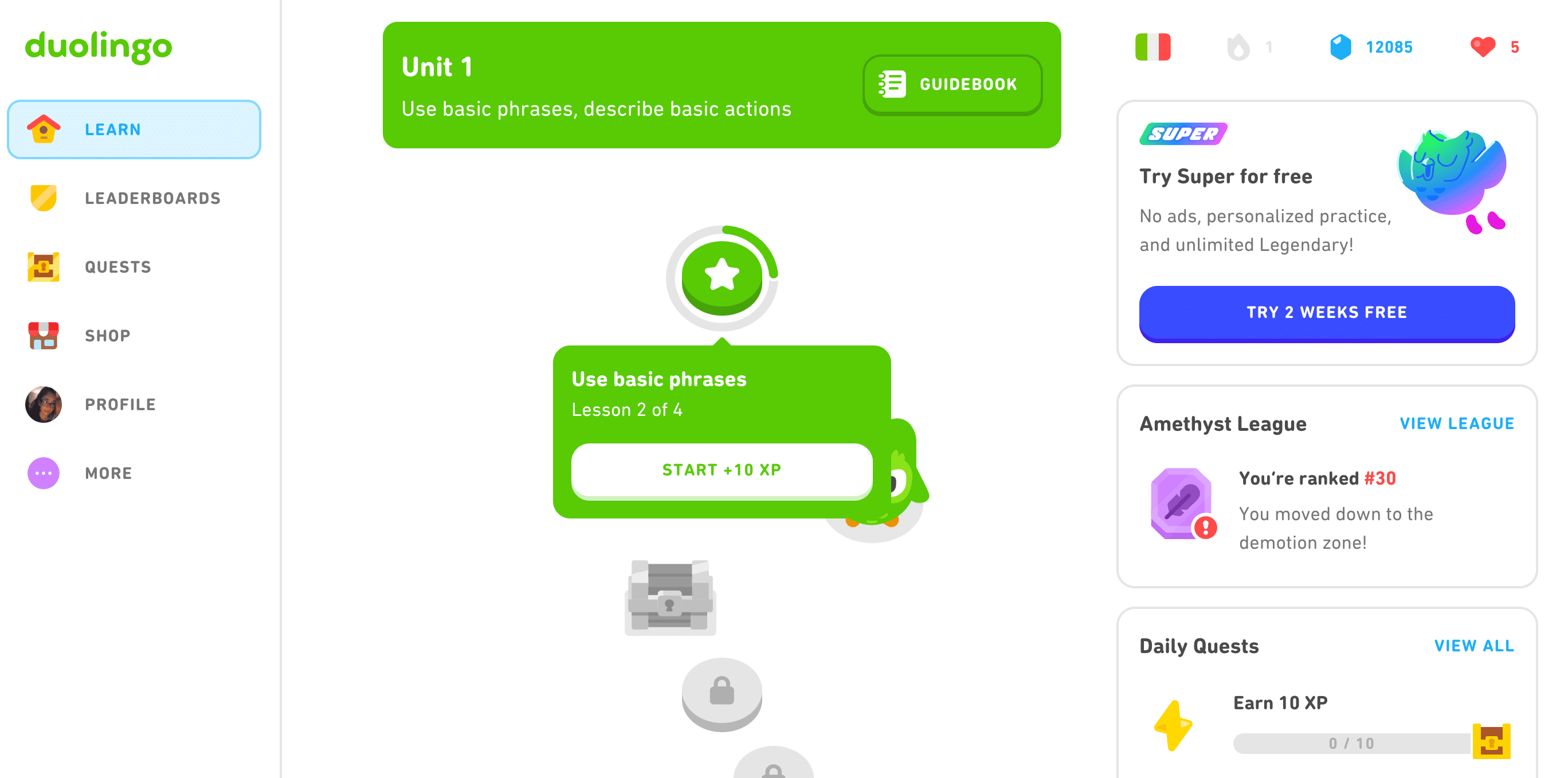
The Italian tree starts you off with the most basic vocabulary, like donna (woman) and lei (she), with the topics getting more challenging as you progress.
With Duolingo, you never feel overwhelmed—complexity is very gradually built from one lesson to the next.
One of the most important elements of the Duolingo experience is its high level of interactivity.
You’ll be doing something every five seconds. The lessons are gamified little exercises or tasks.
For example, you might be asked to pair Italian words with their English counterparts.
Or you might be shown an English sentence and asked to give its Italian translation by tapping on a specific sequence of Italian words.
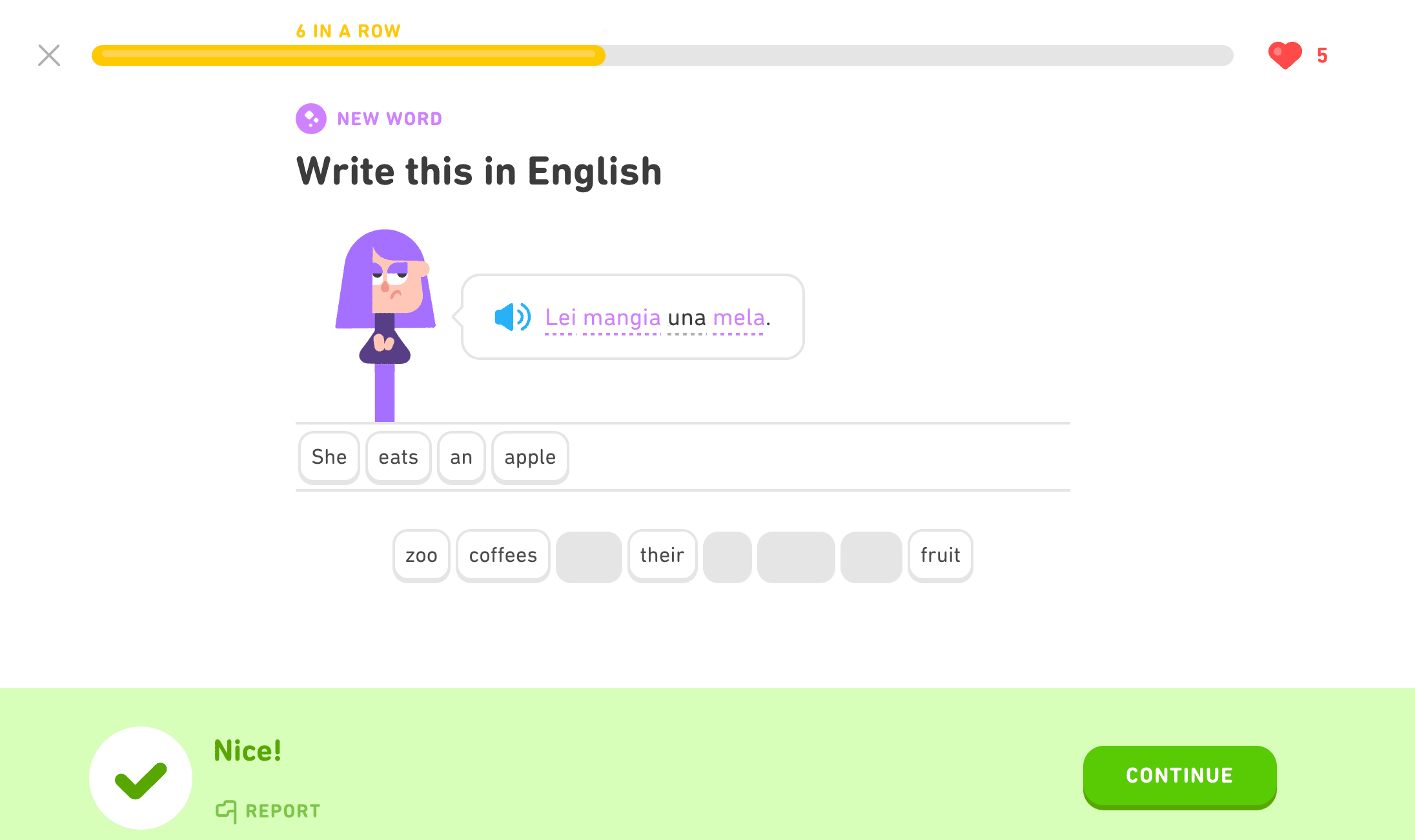
These repeating exercises are really the heart and soul of the platform.
Since Duolingo intends to develop all four linguistic competencies (reading, writing, speaking and listening), there are even times when you’re asked to speak into your phone’s mic and repeat after a prompt.
Then, the voice recognition software checks if your pronunciation is correct or not.
Duolingo is gamified language learning. Every question you answer correctly is converted into Experience Points (XP).
When you’ve finished a lesson or practiced a skill, your XP increases accordingly. (You can set a daily XP goal in the Settings section.)
There’s a leaderboard so you can gauge your performance vis-à-vis other students.
Gems known as “lingots” are the platform’s currency.
You earn lingots for completing tasks like maintaining a 10-day practice streak, reaching your practice goals or inviting friends to use Duolingo.
Lingots can be used in the virtual shop where you can buy “power-ups” like “Streak Freeze” or “Double or Nothing.”
“Streaks” refers to the number of days you’ve consecutively met your XP goals. While XP reflects how long you’re studying in a day, “Streaks” tells you how often you’re studying.
This is really the most important metric for you because it reflects just how consistent you are at studying Italian.
One of the challenges for platforms like Duolingo is to reconcile the different goals and objectives of many different Italian language learners.
Some casual learners simply want a fun time working through the Duolingo tree. Then there are those serious learners who want more in-depth content.
Duolingo has resolved this with “crowns,” which essentially add a new dimension to learning.
Students can breeze through the different lessons if they like, but they can also retake the same level. Each time they do so, the exercises get a little bit more difficult.
You work through the same set of targeted vocabulary, but the tasks required get increasingly difficult.
So, maybe the sentences involved get more complex.
Or instead of tapping presented words to form the translated sentence, this time you need to type the Italian words yourself.
Every time you repeat and finish a level, you gain a “crown.” The max for each level is five crowns.
There’s probably no more robust Italian language learning community than the folks at Duolingo.
You can throw a query out there and have no shortage of replies from fellow learners.
There’s always a healthy discussion going on in the forum and simply reading the threads can be a very educational experience.
You’ll get tips on how to study Italian or be pointed to some useful resources that can get you a needed leg up.
You can also click “Report” after answering a question during your lesson if you think something is incorrect about the way Duolingo graded your choice.
One of the best things about Duolingo—and what makes it so popular—is that it’s free.
Yes, there’s a paid version that comes with no ads and unlimited hearts, but Duolingo isn’t very pushy about it.
Plus, the ads that come with the service are minimally invasive.
But as a free service, Duolingo is definitely one of the best.
The first time you use Duolingo, you immediately get a sense of its smooth graphic interface.
The layout is very intuitive.
The fonts are easy on the eyes. The colors pop but aren’t jarring to the senses. The audio is relatively crisp. The sights, sounds and movement of the elements clue you into what’s happening.
Oh, and then there’s “Duo”—the Duolingo mascot—who occasionally pops up on your screen to shout some words of encouragement.
He’s the easily recognizable green owl who’ll be your companion as you knock out one Italian lesson after another.
Duolingo makes learning Italian feel like jumping through little hoops… and liking it.
There are levels, leagues, leaderboards and lingots. There are streaks to be protected, skills to be developed and a virtual shop to be visited.
Bars are filling up, displayed numbers are telling you something.
The reward system can get you easily hooked.
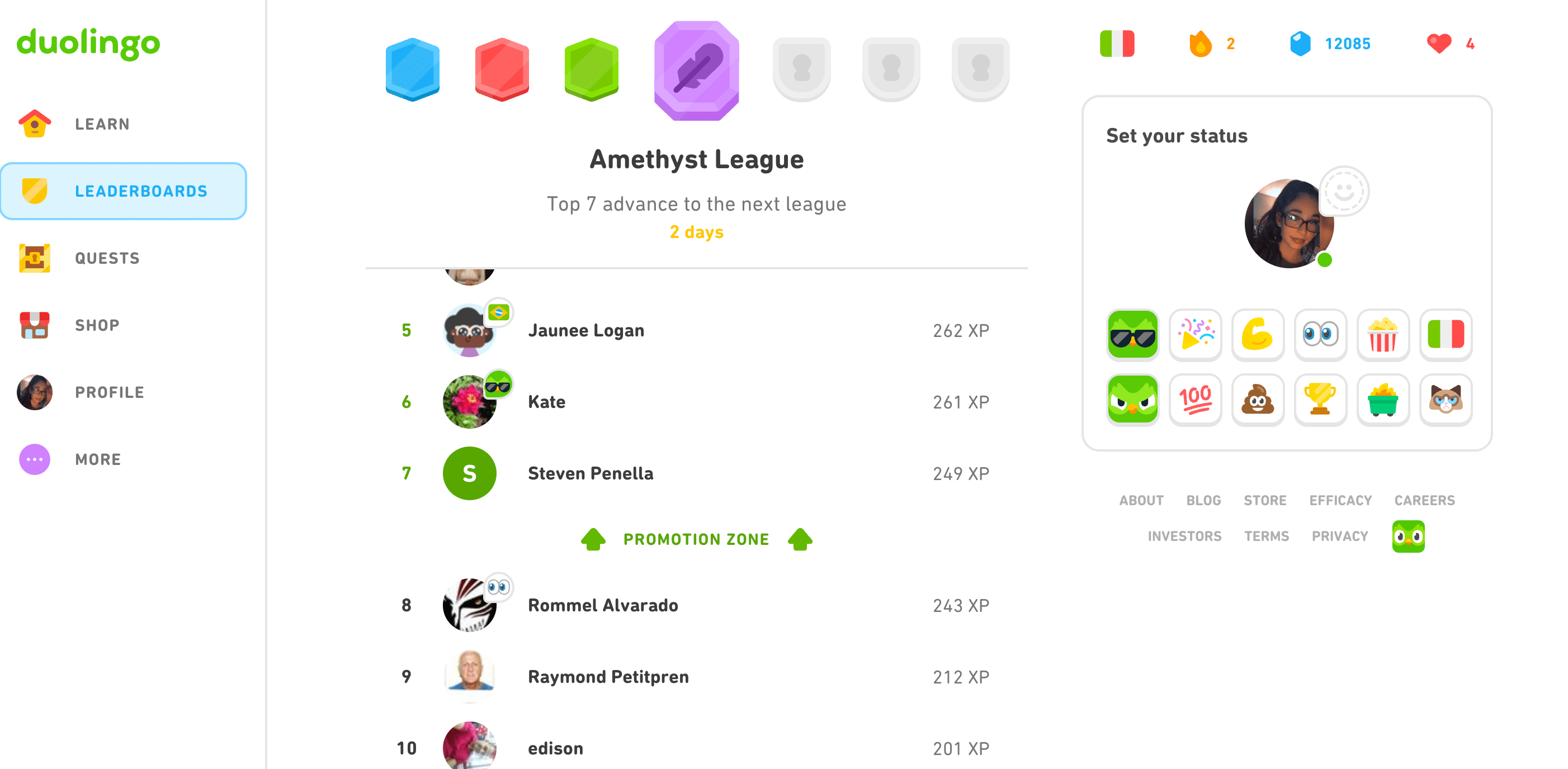
You also always know your progress in the course.
You know if your skills need practice. You know how you measure up against other Italian learners. And the way it presents this information is fun and motivational!
Granted, Duolingo Italian has a lot of room for improvement. (More on this later.)
But as a brainchild of founders with computer backgrounds, you can be sure that the platform uses the latest in machine learning and AI research to improve and keep users motivated.
And because Duolingo has some of the most vocal and passionate users, it can quickly get robust feedback on what needs to be changed.
So expect a continuous flow of improvements on the product.
Many language programs come as individually packaged courses.
So if you’re going to learn Italian, you’d have access only to that course and have to pay or install a different app to study another language.
Well, Duolingo gives you the whole shebang for free.
So, if you’re spent on Italian, you can study Russian for a bit or maybe try your hand at Japanese.
Then, suddenly, you’re sucked in and before you know it, you’re learning multiple languages at the same time.
Many Duolingo users are serial learners and the program makes it easy to give it a shot.
Duolingo has changed the game and is a hard benchmark to beat.
But that said, it’s not the perfect product either. There’s always room for improvement.
Here are a few things that the program could do better.
To be fair, there’s probably no single language learning platform or product that can be everything for everyone.
Duolingo works as part of a healthy mix of other learning materials that would have to include things like Italian textbooks , audiobooks , videos , songs , movies , language exchange websites and so on.
Duolingo has a part to play.
If you want a slew of vocabulary-building exercises that keep close tabs on your performance, then Duolingo is your best bet.
But for other things—like actual conversational practice— the platform might not be the most ideal tool.
I recommend pairing it with tools that let you put your skills to practical use, like language exchange apps or immersion programs like FluentU .
FluentU takes authentic videos—like music videos, movie trailers, news and inspiring talks—and turns them into personalized language learning lessons.
You can try FluentU for free for 2 weeks. Check out the website or download the iOS app or Android app.
P.S. Click here to take advantage of our current sale! (Expires at the end of this month.)

Try FluentU for FREE!
Yes, there are keys to Italian grammar at the start of every lesson, but these feel too “buried.”
(Many users don’t even know that they exist.)
Duolingo could do with a lot more short-but-spunky grammar explanations that are embedded in the individual questions themselves.
When you get an item wrong, you seldom know why. You’re shown the correct answer, but many users are still left guessing why their answer is unacceptable.
Duolingo can do a little more in these instances and use them as teaching moments.
I understand that the platform wasn’t designed for explicit grammar instruction, but a little more grammar explanation—like a well-placed, single-sentence pointer—can be a huge time-saver.
Duolingo doesn’t advocate simply memorizing “survival phrases,” and claims that sentence examples should be relevant and useful in the real world.
But s ome Italian example sentences are so remote from reality that you’d be hard-pressed to think of a suitable moment to use them.
They’re more useful as vocabulary teaching tools than actual commonly-used groups of words. (e.g., Lei é una donna. — She is a woman.)
Sometimes, the sentences sound like they’ve been machine-generated.
Example sentences do get better later in the course, but many users might have dropped off before getting to them.
Repetition is at the heart of learning.
But there comes a point when repetition is too much.
In the case of Duolingo, you might find the exercises begin to rub you the wrong way.
Working with the same words, phrases and sentences over and over can be demotivating.
This is alleviated by algorithms that shelf words you’ve already mastered, but I’m not just talking about vocabulary sets.
I’m also referring to things like that all-too-familiar sound you hear when you get an item right or that distracting buzz you get when you answer incorrectly.
Duolingo could mix things up better and add more variety not only to the content but even to the very mechanics of their exercises.
Duolingo is a very good vocabulary builder, but don’t expect to be fluent when you finish the course.
You’ll learn a lot, but the program won’t take you beyond the intermediate level.
Content development for Duolingo Italian may not have been as brisk as other major languages like Spanish, French, German and Portuguese.
For instance, these languages have “stories”—a feature that challenges your reading and listening comprehension and can seriously address the lack of variety we talked about previously.
Unfortunately, Duolingo Italian doesn’t have this feature yet.
Like Duolingo, Babbel has a structured, well-designed learning path for Italian that starts from the basics and gets progressively more challenging as you improve.
However, there’s a much stronger focus on grammar and the lessons go more in-depth with exercises.
They include the typical translation exercises but also practice conversations. Babbel also offers live online classes (“Babbel Live”) and a podcast.
You might choose Babbel if you want to stick with a resource that will get you to a higher intermediate level. Babbel has courses for complete newbies (A1) all the way up to upper intermediate (B2).
However, Babbel is not free and a subscription only gives you access to one language.
Like Duolingo, Memrise is completely free and is best for vocabulary building.
You can find countless premade flashcard decks—official decks made by Memrise and those made by other students—that use a spaced repetition algorithm to put new words in your long-term memory.
The Memrise official Italian courses start at Level 1 and go through Level 7.
Other decks you can find include the most common 1,000 Italian words, Italian adjectives, verbs, etc.
However, unlike Duolingo, Memrise has basically no (or at most, very limited) grammar lessons, since the courses are flashcard-based.
If you have another resource for grammar and just want to focus on rapidly growing your vocabulary, Memrise might be a better choice to Duolingo.
But if you’re starting from scratch, Duolingo will introduce you to the sentence structures you need to know first.
Most sources online agree that Duolingo can get you to an A2 (or possibly B1) level of Italian alone.
Of course, this also depends on the resources you use in conjunction with Duolingo and how often you practice outside of your study sessions.
There are currently 43 units in the Duolingo Italian course. Each has about 6-10 lessons.
Completing one unit a week would get you through the entire Italian course in 43 weeks, whereas two units a week would take 21-22 weeks.
All things considered, Duolingo Italian is an awesome tool that will build your vocabulary, teach you basic grammar and help you reach an upper beginner to low intermediate level.
Since it only takes five minutes a day, there’s simply no excuse for not working with Duolingo.
I highly encourage you to include it in your resource mix!
If you're as busy as most of us, you don't always have time for lengthy language lessons. The solution? FluentU !
Learn Italian with funny commericals, documentary excerpts and web series, as you can see here:
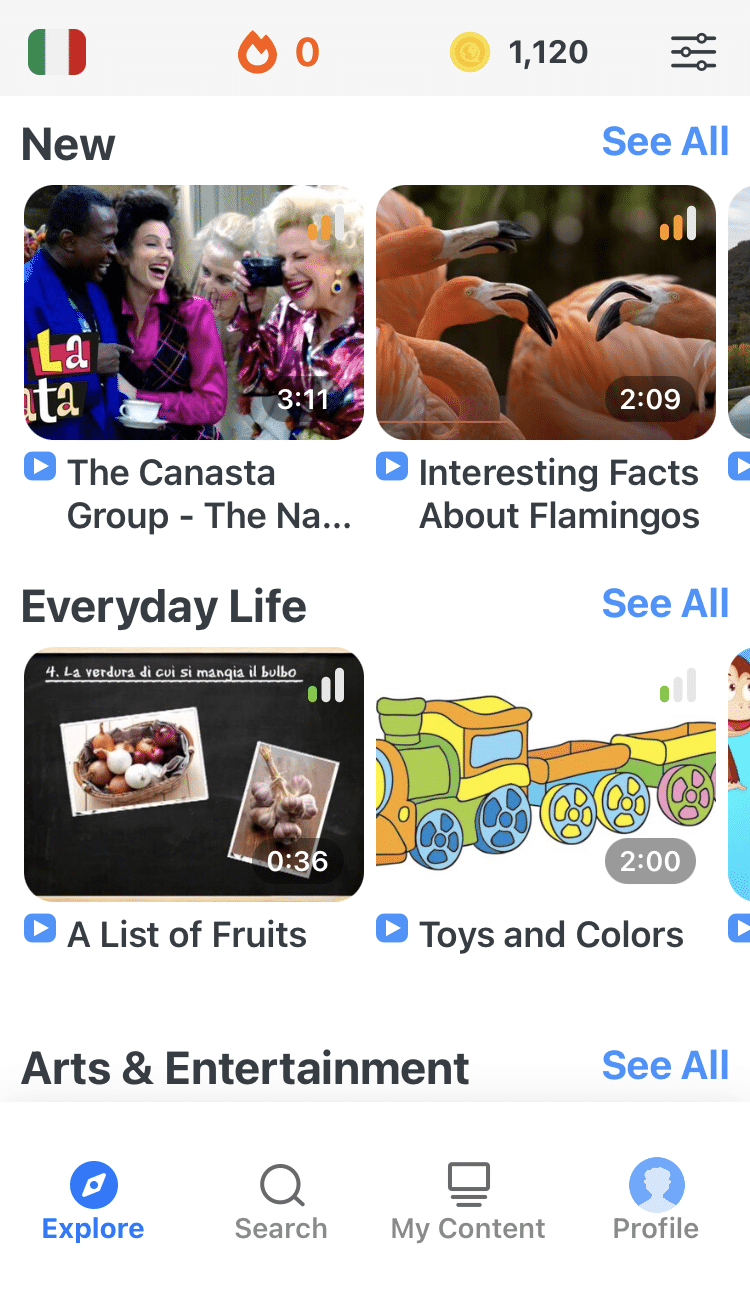
FluentU helps you get comfortable with everyday Italian by combining all the benefits of complete immersion and native-level conversations with interactive subtitles . Tap on any word to instantly see an image, in-context definition, example sentences and other videos in which the word is used.
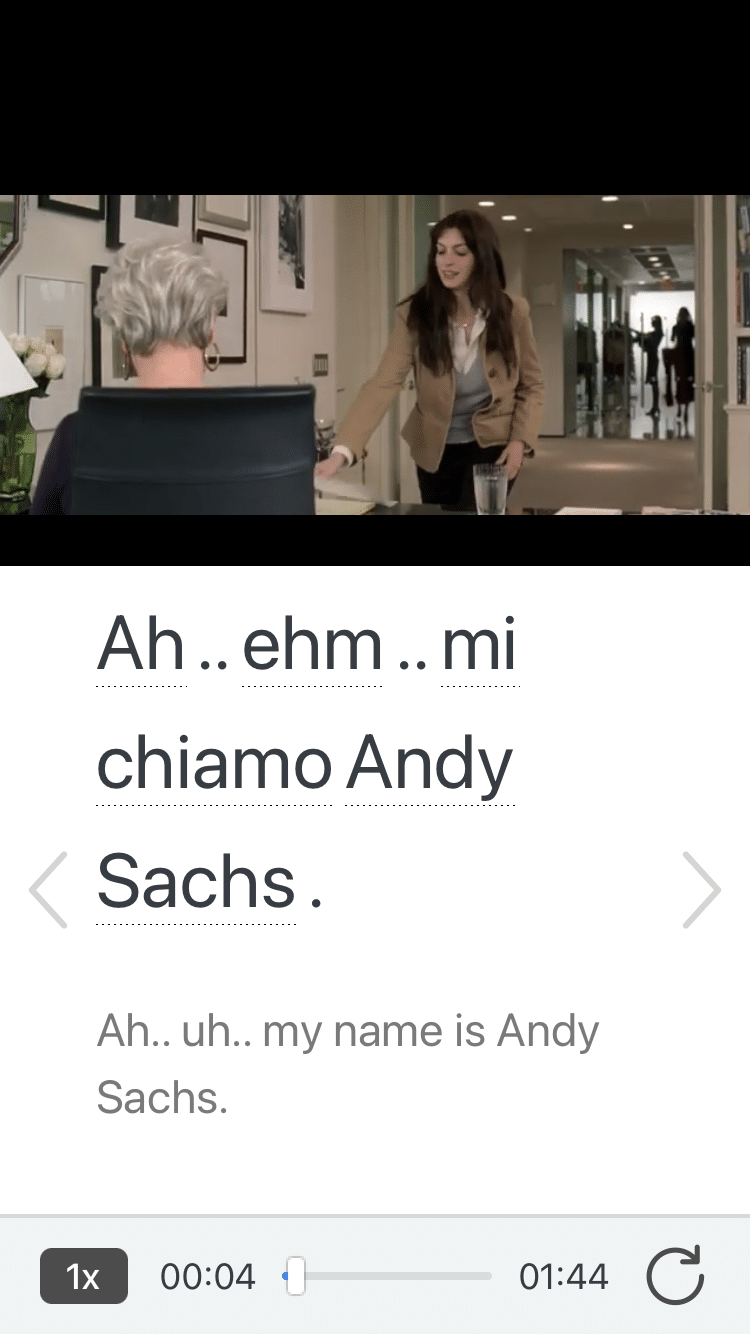
Access a complete interactive transcript of every video under the Dialogue tab, and review words and phrases with convenient audio clips under Vocab .
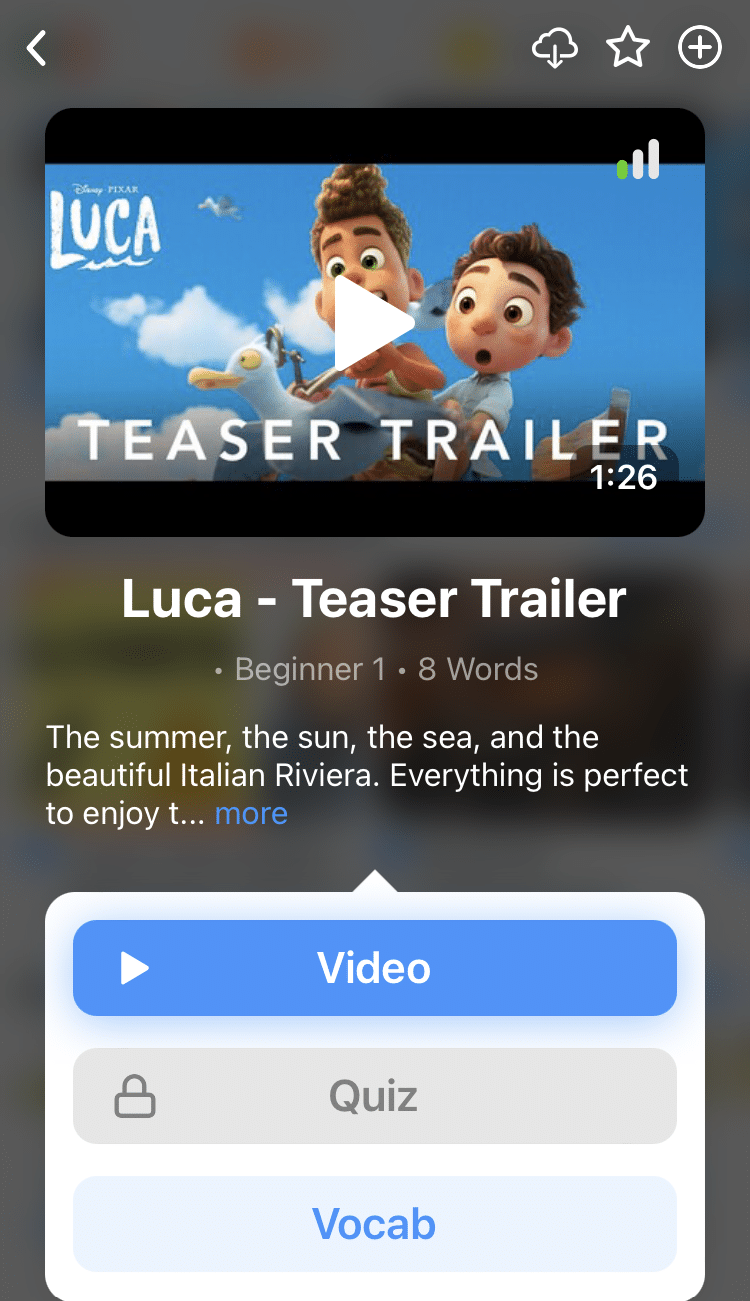
Once you've watched a video, you can use FluentU's quizzes to actively practice all the vocabulary in that video. Swipe left or right to see more examples of the word you’re on.
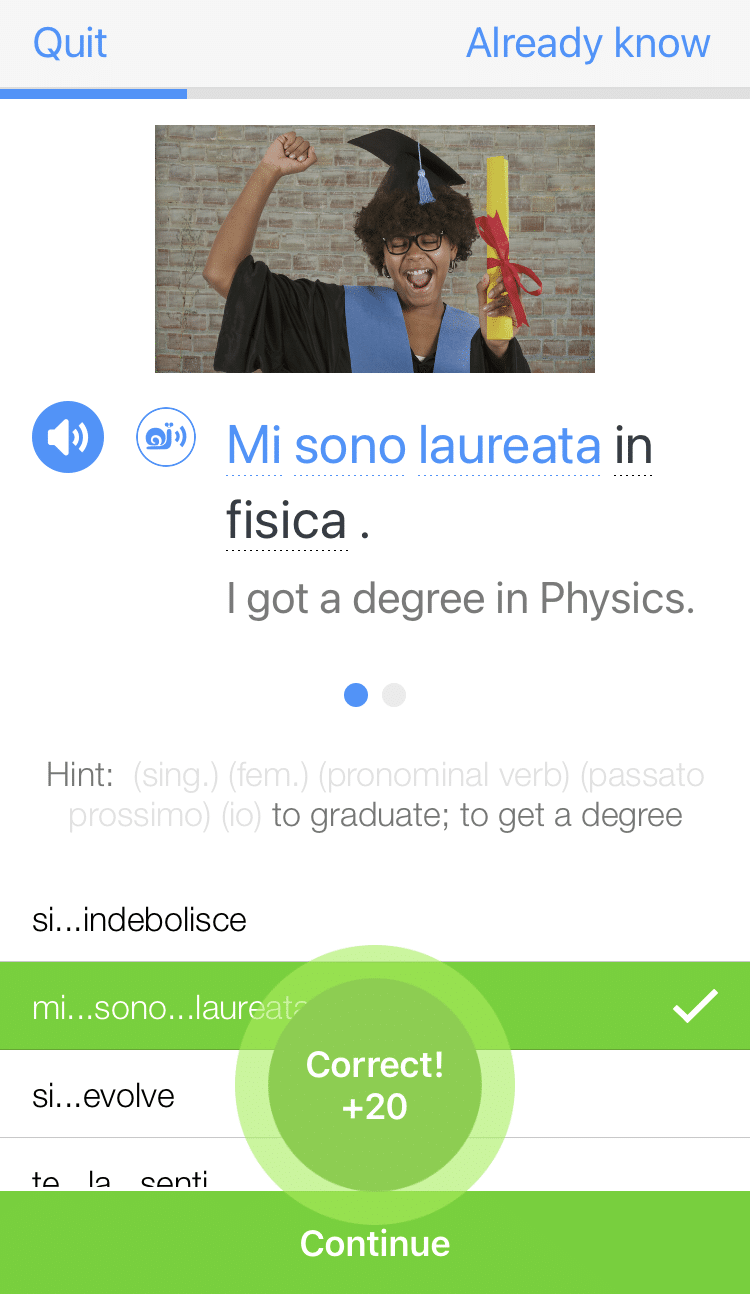
FluentU will even keep track of all the Italian words you’re learning, and give you extra practice with difficult words. Plus, it'll tell you exactly when it's time for review. Now that's a 100% personalized experience !
The best part? You can try FluentU for free with a trial.
Start using the FluentU website on your computer or tablet or, better yet, download the FluentU app from the iTunes or Google Play store. Click here to take advantage of our current sale! (Expires at the end of this month.)
Enter your e-mail address to get your free PDF!
We hate SPAM and promise to keep your email address safe


Duolingo for Italian in 2023 – EVERYTHING You Need To Know
- Posted by by Matt
- Last updated: May 21, 2023
- 9 minute read
If you’re thinking about learning Italian, then you might be wondering whether Duolingo’s Italian course is the course for you.
La bella lingua is spoken by over 66 million people worldwide. It’s an official language in several European countries and currently boasts over 6.5 million learners on Duolingo!
It also happens to be the first language I properly learned on Duolingo — so needless to say I’ve spent a lot of time with the course over the years!
But does that mean Duolingo is good for learning Italian?
In this article, we’ll cover everything you need to know about Italian on Duolingo.
We’ll look at:
- How Duolingo’s Italian course is structured
- Special features
- Other features you need to be aware of
- The pros of Duolingo’s Italian course
- The cons of Duolingo’s Italian course
Ready to dive in?
This page may contain affiliate links. This means that we may receive a commission for any sign-ups or purchases made, but at no extra cost to you . Learn more
What you’ll find in Duolingo’s Italian course
If you’re new to Duolingo, then it’s worth pointing out that all of Duolingo’s courses are structured in pretty much the same way.
There might be one or two slight differences depending on which platform you’re using. However, for the most part, they all look and work the same.
The below represents what you’ll currently find on Duolingo’s IOS app!
The Italian course follows what is referred to as the learning path .

Basically…
The path is broken up into a set of units …

Each unit has a set of levels …

Each level has a series of lessons …

And all of this is organised into a set of sections …

The basic goal is to work through the tree by completing every lesson… in every level… in every unit… in every section.
As of April 2023, Duolingo’s Italian course has a total of 51 units , spread across 4 different sections .
As you move through the path, you’ll get opportunities to complete some timed challenges by tapping on the adjacent characters …

Once you’ve completed a level, you’ll then get the opportunity to tackle an extra-hard challenge to make it legendary …

The exercises in the Italian course are basically the same as in all the other courses. Some of the common exercises you’ll come across include:
- Complete the translation
- Mark the correct meaning
- Picture flashcards
- Select the missing word
- Sentence shuffle
- Speak this sentence
- Tap the pairs
- Translation
- Tap what you hear

Does Duolingo’s Italian course have any special features?
Although English speakers can learn nearly 40 different languages on Duolingo, it’s important to point out that not all of the courses are created equally.
Some courses have special features that others don’t.
Some of these include stories , the Match Madness timed challenge, and AI-powered features (exclusive to Duolingo Max).
As of April 2023, Duolingo’s Italian course has 51 stories and Match Madness , but doesn’t currently take advantage of Duolingo Max’s AI features.
Duolingo Italian Stories
Duolingo’s Italian stories are designed to improve your reading, listening and speaking. They’re entirely in Italian and most of them are only a few minutes long at most.

They’re written for learners of all levels and come with the usual hints you find in the normal lessons.
Every now and then you’ll have to answer a question to make sure you understand what’s going on, which is a great way to measure where you’re at with your comprehension.
Match Madness
Match Madness is one of Duolingo’s main timed challenges.

It’s basically a fancy match-the-pairs exercise, where you have to match the Italian word with its English equivalent.
However, in Match Madness, you have to do this against the clock, and the time you have to complete it gets shorter and shorter in each round.
It’s a great test of your comprehension speed and has quickly become one of the Italian course’s best features!
Other features in Duolingo’s Italian course
Duolingo’s Italian course is built on the same stuff as all of Duolingo’s other language courses.
We won’t go into too much detail here, but some of the features worth knowing about include:
- XP – As you work through the Duolingo Italian course, you’ll earn experience points, which are more commonly known as XP. You’ll earn XP for pretty much everything you do. Some lessons, tasks and exercises will earn you more XP than others.
- Leagues – Every week you’ll be entered into a league with other Duolingo learners. There are 10 leagues to work through, starting at Bronze and ending at Diamond. The leagues are basically leaderboards — simply earn more XP than others in your league to have a chance of winning.
- Gems – XP isn’t the only thing you’ll earn as you learn Italian. You’ll also earn gems, which you can spend in the Duolingo Shop . There isn’t really much you can buy here, but you can use your gems to pick up things like Streak Freezes and Timer Boosts for timed challenges.
- Friends – Duolingo is a social experience, so you’re able to follow other users and compare your progress. The guys at Duolingo reckon you’re 5 times more likely to finish your course if you follow people! To get you started, feel free to give me a follow — my username is DCiiieee !
- Duolingo Plus / Super – This is Duolingo’s premium membership. Pay for Plus/Super and you’ll get access to some useful features, including unlimited hearts , no ads and Practice Hub .
Is Duolingo good for learning Italian?
Now to answer the all-important question:
To answer this, let’s weigh up some of the pros and cons.
Beginner-friendly
Learning a new language can be pretty intimidating, especially if you only speak English.
This is why one of the nicest things about Duolingo is just how accessible and welcoming it is.
Regardless of the language you’re learning, Duolingo presents its courses in a really warm, vibrant and inclusive way. So whether this is your second language or your tenth, you can feel at ease straight away.
Fortunately for English speakers, Italian’s probably one of the easier languages to learn as well. You don’t have to worry about things like cases or different writing systems, and the pronunciation isn’t *that* difficult once you get used to rolling your R’s!
Duolingo makes this even easier with the way it presents its courses. You’ll find helpful guidebooks in every unit, and if you’re stuck on a question you can just tap the words for some hints.
Duolingo’s Italian course also comes with the usual placement test when you first start, so you can rest assured you’ll start your tree from a place you find comfortable.
This is one of Duolingo’s standout features and it’s only available in a few of its courses.
Fortunately, Italian is one of them!

One of the best things about the Italian stories is that they’re genuinely interesting and funny as hell! Duolingo have got some seriously great writers!
They’re so good that reading them doesn’t feel like work. Yet all the while your reading and listening comprehension is going up, up and up!
And while the stories aren’t up to the same standard as some of Duolingo’s other courses (we’ll get to that in a sec) they’re still a HUGE selling point for the Italian course.
I highly recommend getting stuck into them as soon as you can!
Related: Duolingo Stories – The COMPLETE Guide – What You Need To Know
This doesn’t just go for Duolingo’s Italian course, it’s the same for ALL of them!
One of the best things about Duolingo is that it’s more than just a language-learning tool.
It’s also a game . And although this isn’t to everyone’s liking, it’s a big part of why so many people show up every day to do their daily lessons.
For everything you do in Italian, you’ll earn XP (experience points) which contribute towards your position in the weekly leagues.

Now this isn’t something you should take too seriously (you can read more about why here ) but if you take it lightly it’ll definitely make your Italian a lot more enjoyable.
Because ultimately, the more you enjoy something, the more likely you are to do it. And given learning Italian will require you to show up regularly for a very long time, Duolingo could be the perfect solution.
Another great thing about Duolingo is that the Italian course is 100% free .
There is a premium subscription, but this isn’t something you need in order to complete the course. The whole thing is completely free; Plus/Super just adds a few features that make things a bit smoother.
This is great if you’re just dabbling with Italian and aren’t ready to commit just yet. But also if you’re keen to get started with the language but don’t want to fork out on special software or tuition.
Super motivating
I take it you’ve seen the owl memes?
Yes, the owl can be *a bit* of a stalker at times, pestering you at all hours to do your daily Italian lessons!
But relax, contrary to popular belief, he’s not gonna kidnap your family anytime soon!
Jokes aside, Duolingo is brilliant for keeping you motivated .
Learning Italian takes time. It’s not something you’re going to pick up overnight.
According to the US Foreign Service Institute , it takes roughly 600-750 “class hours” to reach “Professional Working Proficiency” in Italian.
So yeah, if you’re going to learn Italian, you’ve got to be in it for the long haul!
That means creating an unbreakable habit. And Duolingo’s amazing for doing that.
Put it this way — my current streak (i.e. the number of days in a row I’ve used Duolingo) goes all the way back to May 2016.
And that’s not just because I’m a bit obsessive! It’s thanks to Duolingo being such a great way of keeping me motivated!
Really short course
Although Italian is currently Duolingo’s 7th most popular course, the course itself is really short .
It only has four sections, which is only half of what you get in courses like French and Spanish.
While the course comes with a chunky 51 units, realistically you could plough through them in a pretty short time.
I first completed the Italian course back in 2016 and I managed to get it done in about a month. And even though Duolingo have updated it quite a bit since then, it’s still a bit thin.
This means that although Duolingo is great for getting started with Italian, eventually you’ll need to look further afield if you want to make significant progress.
Not great for speaking
This is the case for most of Duolingo’s language courses.
Duolingo is brilliant for getting to grips with the listening and reading side of a language. You even get opportunities to practice your pronunciation.
But when it comes to speaking in a real-life scenario, Duolingo’s Italian course won’t get you there by itself.
The problem is the speaking exercises aren’t conversation exercises. You get a little bit of practice in the conversation mode on the stories (if available), but this just involves reciting what the characters say. You don’t actually come up with your own responses.
Speaking is a skill in its own right and to learn it you’ll need to practice it regularly, ideally with a native speaker, or at the very least using a program that has conversation scenarios (such as ItalianPod101 ).
Stories aren’t as good as in other courses
I was really excited to see stories come to the Italian course back in 2021. Considering how popular the course is, they were definitely overdue.
And while they undoubtedly improve the course, unfortunately, they don’t hit the heights of the stories in other courses, such as French, Spanish and German.
One reason is there just aren’t that many. As of April 2023, there are only 51 — which is pretty low compared to the French course, which has nearly 300!
Another reason is they just don’t read as well as in some of the other courses. The French stories are full of life with real voices. Whereas the Italian stories sound as though they’re being read by robots.
They’re still good, but they could be so much better.
If you’ve read any of my other articles then you’ll know one of the things I dislike most about Duolingo at the moment is the heart system .
Hearts are basically lives or chances. You start off with 5 then lose one every time you make a mistake.
If you lose all your hearts then you’re not allowed to progress through your course until your hearts replenish.

You can either watch an ad to get one back, do a practice session, spend some gems or wait 5 hours.
It’s far from ideal as it does the unhelpful thing of punishing you for making mistakes .
Which, as far as I’m concerned, is ridiculous as mistakes are absolutely essential and unavoidable when learning a language.
If you’re a total beginner or simply on the fence about learning Italian, then Duolingo’s Italian course is definitely a great place to start.
You’ll learn the basics of the language, get to grips with the pronunciation, pick up a nice chunk of useful vocabulary, and see the language in action in 51 mini-stories.
You’ll also have a blast working through the course as you compete in the weekly leagues and alongside your friends!
By the end of the course, you’ll definitely be more advanced than when you started.
However, given that the course only has 4 sections, you’ll need to use other resources as well if you want to reach fluency.
By itself, Duolingo’s Italian course could probably get you to an A2 level in reading and listening (so long as you’re doing enough passive learning as well).
A good tool to use — either alongside Duolingo or after you’ve completed the course — is ItalianPod101 .
ItalianPod and Duolingo complement each other beautifully, as they both target areas that the other misses. Duolingo is great for reading and typing things out, whereas ItalianPod is brilliant for improving your listening and speaking.
With ItalianPod you’ll also get essential resources like grammar packs, cultural insights, and learn the 2,000 most common Italian words — so by the end of the course, you should be able to understand as much as 80% of all Italian conversations.
When used together, Duolingo and ItalianPod will give you everything you need to reach a comfortable level in Italian.
If you’re new to Italian…
I’d highly recommend taking Duolingo’s placement test, figuring out what level you’re at, and then working through the first couple of units. This will get you familiar with the basics of Italian.
At the same time, I’d recommend taking advantage of ItalianPod’s free trial to get familiar with how the language sounds, pick up some useful phrases and cultural insights, and practice speaking as soon as possible.
Once you’ve worked your way through the Duolingo course, I’d recommend coming back to it daily to keep the streak alive (habit is SO important when learning a language) and start to move through the intermediate to advanced packs on ItalianPod.
Finally, make sure you’re getting enough passive exposure to Italian as well. It’s really important to experience the language in an authentic environment — so things like TV shows, music, books, real-life conversations — so you can see how everything you learn on Duolingo and ItalianPod works in the real world.
Hey! I'm Matt, the Duolingo-nut behind duoplanet. I started using Duolingo back in 2014, and my current streak stretches all the way back to May 2016. Using Duolingo I've reached a comfortable level in Italian and acquired a basic understanding of Russian. I've also gone deep into the Spanish, German and French courses, and intend to explore more languages in the years to come. Needless to say, I'm obsessed with language learning!
Post navigation

Duolingo for Russian - EVERYTHING You Need To Know

Duolingo for German in 2023 - EVERYTHING You Need To Know
Leave a comment, leave a reply cancel reply.
Your email address will not be published. Required fields are marked *
Save my name, email, and website in this browser for the next time I comment.
related posts

Duolingo Stories in 2024 – EVERYTHING You Need To Know
- 5 minute read

The Complete List of EVERY Duolingo Language in 2023
- 4 minute read
- Tour Account ›
- Travel Forum ›
- Travel Forum
- Did Duolingo Ital...
Did Duolingo Italian help you?
We have been to Italy multiple times and easily survived on "Buongiono, per favore, grazie, ... etc" to be friendly. We have a 1 month trip starting in mid-August.
My wife and I are trying out Duolingo to extend our Italian a little. I know that Duolingo is perhaps not the best conversational choice as I have read that Pimsleur is very good for conversational. But Duolingo is free or low cost and I'm not sure how far I will take this. I have a history of poor language proficiency, poor audio skills it seems. So I don't expect any real level of fluency.
I see that the first lessons deal with being in a cafe, navigating a city, ordering in restaurants. Might be useful. Probably in addition to using Google Translate more of Italian conversation could be at least somewhat familiar to my ear.
If you've done several Italian Duolingo lessons, how did that work out for you in Italy?
I have used Duolingo to try and keep my semi-fluent Italian active. I like it, overall. The repetition is not as boring as some other programs and the grammar is taught not pedantically, but in use, as a child would learn speech parts like prepositions. I also like that it makes you practice listening, reading, and speaking so you get used to the pronunciation.
Admittedly, I have ad the benefit of classes as community college, Pimsleur self-study (excellent), and living and traveling in Italy. Still, for the price (free!) Duolingo is good. The upgraded paid-for subscription is, IMO, even better.
There are also some nice podcasts out there. You might explore those in conjunction with Duolingo and listen to them on you commute or while walking to get ready for all the walking you'll do in Italy.
Thanks Laurel. Do you have any recommended Podcasts in mind?
When the material is audio only I find that I want to see the words too. But realistically that's not what will happen in Italy.
I recently listened to a few Podcasts but they were way over my ability to follow. My guess is it helps to have some rudimentary Italian skills before venturing into short stories and such. But I could be wrong. I'm fine with starting at a 2 year old's level. :)
I haven't used Duolingo but I had access to Mango which I think is a similar on-line tool that teaches general basic Italian with something of an emphasis on directions, ordering, where you live etc. I found it really helpful but what I found I lacked was confidence and that was what help me back.
I was lucky enough to go to Italy both in 2022 and in 2023 and I studied essentially the same language program before both visits but the difference was having the confidence to actually use it the second visit. The first visit I had a number of times I wanted to say something but assumed I didn't know how and froze up. After the fact I realized I knew how to say what I wanted but I just kind of assumed I didn't. When I approached the 2023 trip I had studied much of the same material but I approached it with more determination and did fairly well. I only had to resort to Google translate once because the question I was asking was too complex for me in Italian and person behind the counter did not speak enough English to fallback to that.
I found that studying on-line made me better at making declarative statements but less good at conversation because I wasn't used to listening, translating and then answering in real time. But I found that the Italians are very encouraging and happy you are trying. I got a lot of "Italian is really hard, but you're doing well!" even when I didn't feel like I was doing very well.
The only other thing I'll add is that if you have been studying don't try watching Italian movies or TV to test your proficiency. When I watch Italian TV I feel like I speak zero Italian, but I was able to get around well enough so don't compare turistico needs with native speaking. I start Italian 101 at the local community college in about two weeks, wish me luck...
Italians will appreciate any effort with the language so I encourage you to try, =Tod
I haven’t used Duolingo for Italian, but I did use Wesleyan University’s free Italian for beginners course. It helped a lot and enabled me to speak to Italians. Another good resource is Coffee Break Italian. The podcast is excellent and allows you to practice and build your abilities gradually.
Thanks for the idea of Coffee Break Italian podcasts . I found the seasons on Amazon Prime Podcasts (Amazon Music app) which I can download to my iPhone. Might work out as a nice complement to Duolingo on my walks in the park where cellular is spotty at best. I think this is ad free listening too.
The Washington Post recently ran this story about how Duolingo is increasingly using AI to construct its lessons, and users described in the Comments section that they are noticing nonsensical answers. (gift article so there should be no paywall)
Not free but excellent is Dartmouth's Summer Italian intensive : an online, 5-day course offered over 1 week once each summer. It was taught in mid-July in 2023 and 2022, so I'm assuming the same for 2024. If you have the time available, it would give you Italian just in time for your trip! Dartmouth's Rassias Method creates a learning environment that's fun and safe from embarrassment and focused on getting you to think in the language. Emphasis is on speaking and understanding. They offer multiple levels and this is one of the keys to their success - you will be well matched with your groupmates in terms of how much Italian you already have, and so you make a lot of progress together in a short time. Dartmouth also offers a semi-intensive online from Jan 23 to Feb 29 on Tues/Thurs evenings Eastern Time. Registration deadline has already passed but they can sometimes/often accommodate late registrants. Dartmouth's method of teaching was more effective for me than any other format (college way back when, asynchronous online course, podcasts, weekly private tutor, weeklong classroom course in Italy).
Besides Dartmouth, I've gotten the "next most" out of Italian with Davide , a (paid) structured asynchronous online course - but registration only opens once or twice per year so if you are interested, sign up to be notified. I heard about Davide from an interview Sarah Murdoch did with him a few years ago and I thought his beginner course was really well organized and useful.
I did Coffee Break Italian for a while, and liked their format of "little bites" - it's offered both in podcast or on YouTube/their website. The benefit of watching the video for me is that I can understand better if I can see the speaker's face and see their written notes. But it's also good practice for me to try to understand just by listening.
Whatever you choose, buona fortuna e buon viaggio!
People worry far too much about learning Italian prior to going there, and years ago I did the same. Italians and most Europeans start learning English in school at a very young age, and generally any European younger than 45 or so is fluent in English. That has been my experience after many trips. Yes, it’s fun to learn some new words in a foreign language, but using your new words is difficult unless you can follow up quickly when they respond to you! IF they don’t respond in English. So have fun with your Buongiorno and grazie but don’t worry about much more than that.
I used Pimsleur Italian up thru level 3 (it goes up to level 5) before a trip last fall. I'll give it mixed reviews. It was great for producing sentences. There were a bunch of things I could say as easily as I'm typing this now. But I had little ability to understand responses. The sad thing was many responses were mostly or completely words I knew but when spoken at conversational speed and pronounced correctly in Italian I did not recognize them. So Pimsleur has it's place but isn't the complete solution.
The linguist John McWhorter wrote a NYT article recommending using Glossika, which has several thousand sentences in graded levels of difficulty. By listening to them repetitively the idea is that they can come to seen as natural as production does using other programs. I'm going to give it a try before another trip to Italy this fall.
Hi Les, I applaud your desire to want to learn more of the language.
I love visiting Italy and staying in over thirty Italian cities, it’s definitely been used! And it has been wonderful to be able to speak some Italian, even if I am still a beginner level. And it’s certainly appreciated from locals both as being courteous and to show we are interested in their community.
I used to practiced languages with Duolingo, some game CD’s, Italian for Dummies, YouTube language videos, etc. when I was getting ready for my next trip. Preparing for staying 32 days in more remote Italian regions this year, I have been seriously studying with Duolingo. I’m on consecutive Day 136, (purchased a year two months ago), spending at least an hour each evening on it and am at their top Diamond level. I took it as a good sign when I could say a few Italian sentences in my mind if I wake up during the night - LOL!
I do have two sheets of paper where I wrote out sentences that I would like to be speaking in hotels, in restaurants, train stations, a museum, etc. For example, “I would like a table for two, please.” “Could we make a reservation for dinner tonight?” “Could I have my key, Room #123, please?” I like writing it out myself to help with the memory, and I reviewed that page on the plane and in my room the first few nights. By then, it should be familiar.
If you study Duolingo for awhile, some of the comments about food in the Italian lessons are quite entertaining!
The typical tourist who spends a week or two in the major cities in Italy does not need to worry about communicating with the locals in Italian. Yes, it’s fun to learn more and to use it but that takes a lot of studying and patience from native Italians when you do try to converse.
Google Translate app gives you the option of saving many phrases, of your own devising , in many languages. You can also hear each one as well. You could do this , and practice saying them all before your trip. I also like Mango, we get it through our local library website. Perhaps some language cd’s from your library might help, too?
Good for you for trying hard to learn before your trip!
I am using Mango as well through my library's free access for a tour de France/Paris Olympics trip this summer, and I am hopeful. I think I am focused on learning French because the last time I traveled in a country I didn't speak the language (I know general Italian and Spanish) was over 15 years ago (France and Germany) and I feel very different in a place I can't communicate well in. I don't know if I will have time to learn to my general knowledge of Spanish (definitely not as good as Italian, but I will be in Nice first so I will probably be able to ease into the French with a bit of Italian hahahah) but I want to be able to be at least a general step above the basis of "politeness". Here's to hoping!
Even though last time I was in Italy I said "do you have space for two?" in Italian and the waiter said "You speak great Italian!" when I literally only said 4 words, I want to be able to at least converse in a restaurant and get directions to places in France.
But for the OP, check what your library card can get you access to, as using in conjunction with duolingo might help even more!
Also, getting used to just HEARING Italian will help, I am concerned about just identifying words in French at the moment, much less even translating them, but I am certain that your PBS station/app has a lot of Italian shows with English subtitles (sottotitoli! I like saying that hahaha) you can get used to listening to.
I have been watching a French one and I for sure can identify the word for "today"! (from that show as well as tour de France French interviews hahaha)
I used Duolingo German and found it very helpful. It gave me a good foundation with which to branch out to Coffee Break German (I see you've already discovered the Coffee Break series) and to Easy German on YouTube (check and see if there is Easy Italian; there probably is). I learn best with a combination of structured grammar lessons and listening to/participating in coversations and Duolingo was perfect for that part of the combo. I haven't found anything else that worked as well for me. I know some people really hate on Duolingo, but I never went into it thinking it would make me fluent. I wanted to learn some basic grammar and vocab for a trip and just six weeks of Duolingo made such a difference in my first trip to Germany that I continued to study it somewhat seriously up until 2021.
Thanks very much for all your replies. Have given me some good ideas to follow up.
Keep them coming. :)
My husband and I traveled to Italy last year for the first time. It's been decades since either of us have needed to navigate not in English, but once upon a time I could have a broken conversation in French and he's had some Spanish. I found Duolingo to be perfect for what we needed -- I practiced daily for about 5 months before we left. What I found the most helpful about what I learned is that I could mostly read the signs -- I could figure out how to buy a ticket or read a menu or tell if that sign meant the hiking trail was closed or it was only closed between X-Y days and we were there on day Z. I definitely didn't know enough to have a conversation, but I learned enough to be able to comprehend other's questions of me.
Carrie, good point. I have used the Google Translate and camera in that app to read some signs and menus. But sometimes it is a bit hard to get the app to read the fonts on the menu. Or at least it was in the past. Would be nice to know more Italian words right off the bat. And I could also read Italian advertising ... well a mixed blessing indeed. :)
Good for you, Les, working to improve your Italian. as so many people here have noted, more capacity with the language will enhance your experience.
Can you get along without it ? Yes. Is it a lot more fun and a richer experience with it ? Also yes.
I agree that if you're staying in bigger cities you don't need to know Italian, but I think it helps open the culture up to you if you can manage some of the language on your own. I know Italians appreciate the effort and you never know what opportunities might open up to you if you can manage a conversation with a random stranger or shop owner.
We were in a non-touristy town and stopped in at il bar one afternoon for a chinotto and sandwich and the lovely woman who ran the cafe brought our food and was really upset explaining that she had dropped half my panini taking it out of the press. She was making me another one and had brought me the surviving half. It was absolutely not a big deal but she seems really upset. Thankfully my Italian did not abandon me in that moment and I was able to say "Non si preoccupi" which is "Don't worry about it" (formal) and it really seemed to help her calm down. I'm still glad I managed to say the right thing at the right time. It's a small victory but it helped me feel like was more part of the local scene a little bit than just a tourist.
Another phrase I recommend you learn is some version of "L'inglese è il mio preferito" meaning "I prefer English". This helps when you walk into a place and speak Italian and get a stream of Italian in return that you can't understand. They will quickly figure out from your 'deer in the headlights' look that they should change languages but this phrase will let you speak for yourself. Also in the north where German tourism is popular I was mistaken for Germain more than once and I was asked if English was okay as the compromise language and I was able to say "Yes" using this phrase.
The only other thing I will say is that even if you learn some Italian the differences in towns will keep you off balance. In Bologna I was greeted with " Ciao, salve!" walking into stores rather than " Buongiorno " and they insisted on using the word calice for a glass of wine rather than bicchiere which I had never heard. When I asked in Venice they said they would use bicchiere as I had expected.
And some places you order at the bar and pay upfront, some you order at the bar and pay later, and others you order at the table. Italy will always keep you guessing and you need to embrace it and just roll with it. Learning some Italian will help but I still always felt like Italians were dancing to some music I couldn't hear. They breeze into restaurants, grab tables and order drink while I'm still trying to figure out who to talk to. Just roll with it and admire the Italian bella figura with tehir ease and grace without being too jealous.
Have a great trip, =Tod
Thanks for telling those Italy stories Tod. Those small connections with the natives can make for a richer trip experience.
hiredman " l'inglese è il mio preferito " means " English is my favourite ". The correct translation of " I prefer English " is ", preferisco l'inglese " which sounds a little too "direct" if used as a request. A more formal way of asking to switch to English could be: "mi scusi, possiamo parlare inglese?" or "si potrebbe parlare inglese per favore?"
Duolingo was fun to work with while at home, but brain lock kept me from actually using much of it verbally. Same with Babel & Italian for Dummies. One point to consider, all these teach Italian . Vast numbers of "Italians" actually primarily speak their local dialect, so learning Italian to speak to them is learning their secondary language (English being their 3rd - got to admire their ability to move between languages). And don't even get me started on Sicilian (my family's heritage). However, all those teaching resources did - as others have mentioned - help me understand written words on signs and menus, so that was useful.
Thanks Tobia, that is one of the limitations of taking an online course without real exposure to the language. In Italy I find salve to be a fairly common greeting but have never heard it mentioned in any formal Italian course I've taken. I had an Italian tell me that if you use salve Italians may assume you are a better Italian speaker than you are.
I should have been more clear because my usage of "l'inglese è il mio preferito" would come after we had exchanged pleasantries in Italian and were moving onto more substantive discussions. They would ask me something too complicated or fast for my Italian and I would ask them to repeat it more slowly "Ripeti lentamente, per favore" and then we would generally start the language negotiation. One funny way to say it I learned from my American friend who has a place in Italy is say "Piano, piano" accompanied by a kind of double hands up open and closing motion. I have no idea where it's from but it never fails to make Italian people laugh and also they understand that you're struggling with the language.
Also as I mentioned I was mistaken for German more than once and was asked essentially if English was okay as part of a preemptive negotiation and later they were surprised to find out I was American. In Arezzo I was asked if I spoke German by a shopkeeper and I said "Ich spreche ein bisschen Deutsch" because I took high school German but again it turned out English was the common language we both spoke but she had been learning German and was looking to try it out on a native speaker.
So the good news for Americans is that English has become the common language in Italy that shopkeepers will try to land on for tourists from all over the world. But I struggle to learn what I can of the local language because I'd like to be as inside the culture as I can.
Buon viaggio, =Tod
In my first Duolingo lessons, "salve" is used rather then "buongiorno". Different users might be experiencing a different plan structure or also the lessons may have been updated.
To the OP's question: yes it helped me. Yes, there are probably better, but it was free and convenient. I did Duo Italian for 180 days straight during COVID as part of my morning routine. Much of that has been lost since, but I'd go back to it if I was going to Italy anytime soon.
@hiredman - Yes, it is always tempting to ask an Italian you are trying to converse with to slow down with their speech, however, I try not to ask anymore after being told by an Italian acquaintance in Italy that “Italians HATE that!” which maybe depends on the person, but I certainly stopped asking him!
oooo! Talking about "salve" vs "buongiorno"!
So you are supposed to greet all shopkeepers when going in and out of their stores, usually a "hello" of some sort, and then a "grazie" on the way out. I would always say "buongiorno" during the morning times, but since neither "buon pomerriggio" or "buona sera" (as my friends said was ok for anything after noon) felt right, I settled for a "salve" all times between 12pm and 5pm :)
Perhaps this is a regional thing, but when I stayed at Allogia Barbaria in Venice in 2017, the owner told me that 'salve' was more impersonal. He said that's how he would greet "the tax man." :-)
And, I completed Duolingo's Italian course, and am now working on the French. Certainly not necessary for travel, but, for me, it does make it more fun to be able to engage locals in their own language. Haltingly, at times, but I've found the effort to almost always be appreciated.
Hi Les, circling back on your post. I mentioned that watching some YouTube videos for beginner’s traveler’s Italian from native speakers were really helpful, too. One of them shared “Va bene?” which I used often in the smaller cities and even in Venice last time. It means “All right?” or “Is it good?”, so when you want to sit at a table in a piazza to have a drink, catch the eye of the waiter and ask it, pointing to the table you would like. It saves them time, and you also have been courteous.
I have tried Duolingo for 10 days. Probably a bit too much repetition of very easy cafe talk. It is kind of fun. And maybe the repetition will be good for me.
I also have been trying Mango as suggested above by others. It seems to be better in that there is more explanations and also so far an emphasis on formal rather then casual vocabulary. As an older adult traveling I am not going to hit the young nightlife and already have a wife. :)
Coffee Break Italian podcasts are good for my walks.
Please do not reply to violations of our Community Guidelines .
Dear Duolingo: How can I keep my streak while on vacation?

Welcome to another week of Dear Duolingo, an advice column just for language learners. Catch up on past installments here .

Hi there, learners! This week's Duolingo is brought to you by Mykhaylo Zakryzhevskyy—who's written about learning multiple languages and offered grammar tips for English learners —and Brandon Lesher, who's new to Dear Duolingo! Brandon is a Senior Curriculum Designer with extensive English teaching experience, and earlier this year he wrote about different English dialects . We're writing to you this week from Duolingo's headquarters in Pittsburgh, Pennsylvania, where it is finally starting to feel like spring! 🌱 So this week's question is one we've been asking ourselves as well…
Our question this week:
Dear Duolingo, I'm a little obsessed with my Duolingo streak. I'm almost at 400 days, and all my friends and family have seen me do lessons to keep this streak going: at dinner, on holidays, in the middle of conversations, and even once (or twice?) at my own birthday. But I'm getting worried! I have a few summer trips planned, and I'm really worried about forgetting about my lessons. What do you recommend to help? Thank you, Travel Adapter
We have to confess: This sounds a lot like us. 😬 All your bags are packed, you're ready to go, but did you make room in your suitcase for your streak?
Language learning can be hard when you are traveling, so here are some quick and dirty tips to help you continue your learning, keep your streak going, and exercise your brain, from anywhere in the world!
Gamify your learning
When traveling, use the gamification features built into Duolingo to keep language learning on your mind! Here are 3 ways to make gamification work for you:
- Hoard gems before you travel. You can take advantage of Duolingo's gem economy to buy yourself some leeway for when you're on the road. By foregoing a few timer boosts or Streak Freezes before your trip, you can use those gems to freeze your streak during the trip when you might not otherwise be able to practice. Just remember to keep coming back to the app to refill your Streak Freezes after they're used!
- Save up your Streak Freezes. Be strategic about your trip and plan in advance to keep some Streak Freezes at the ready. (This is another use for gems!) You may find yourself without WiFi or cellular service in another country, but if you’ve saved up a couple of Streak Freezes (the free app allows you to store 2 Freezes), you'll be covered for any tricky, off-the-grid situations.
- Do lessons that feel the most manageable. Decide which lessons are the easiest for you time- and effort-wise, and make those your vacation priority. That could be doing a review lesson in the Practice Hub or redoing a Story in your course. Match Madness is also a great choice when you are on the go, and there is no shame in doing something quick to keep that streak going, or to keep from dropping down a league!

Adapt to your new schedule
Your daily routine will be pretty different while traveling… if you have a routine at all! 🏝 Building new study habits will be necessary to keep your learning going.
- Look for convenient opportunities to fit that lesson in . Do a Duolingo lesson while waiting in line to buy your train or bus ticket or at the airport gate, right before boarding your plane. There's always a lot of waiting happening at tourist sites, but you can be productive in the meantime!
- Be careful with crossing time zones . Try to do a lesson before you get on that flight and immediately after you land to preserve your streak!
- Find yourself a Duolingo buddy. Learn with a friend, or even your travel companions! Follow them on the app, and hold yourself accountable for doing at least a lesson a day. You can also message each other reminders (and check on each other in person!), and send each other encouragement through the app. If you happen to be learning the same language, practice using it with each other and the locals you meet.
- During your vacation, enable notifications. Even if you normally have notifications off, you might find them really helpful while on the road! Especially if you're getting dangerously close to losing your streak or getting kicked down a league 😭
Look to your destination for inspiration
If you're traveling to a place that uses the language you're studying, you can make learning part of your sightseeing plans! Finding motivation in your destination will get you excited about the new place you’re about to visit.
- Research where you'll have Wi-Fi. Searching for Wi-Fi will likely be part of your daily schedule while on the road, and you can use that signal to fit a lesson in! While looking up famous cafes and restaurants and researching top tourist destinations, check if Wi-Fi is available. Many cities around the world offer it in public squares and parks, so you could be doing your lessons in some memorable outdoor places! 🗽
- Practice the language “out in the wild.” This is probably the single most useful (and exciting!) piece of advice: Try out what you’ve learned with the locals! After doing a lesson in the morning, see if you can use one thing you learned “out in the wild” to order a coffee in Italian in Rome or check into your hotel room in Berlin using German . For those learning French or Spanish, Duolingo Max now offers real-life practice conversations powered by AI, so you'll be ready to introduce yourself to a local and buy some fresh fruit at the bodega next to your hotel!
You don't need to take a vacation from learning!
Traveling is all about trying new food, exploring new places, and connecting with the locals. Enhance your travel with these easy tips for how to keep your language learning going, and your traveling will be more exciting and relevant!
Related Posts All Posts
Dear duolingo: what are the different writing systems around the world, how kpop can teach you about korean culture.

What Level Is Duolingo Italian? A Comparison With Language Proficiency Levels
If you are you considering the Italian course in Duolingo but are not sure if it is the right level for your Italian, then you are in the right place.
This article will detail what level of Italian each Duolingo section corresponds to, so you will get an understanding of what material the Duolingo Italian tree contains and how complex it is.
Keep reading to find out more!
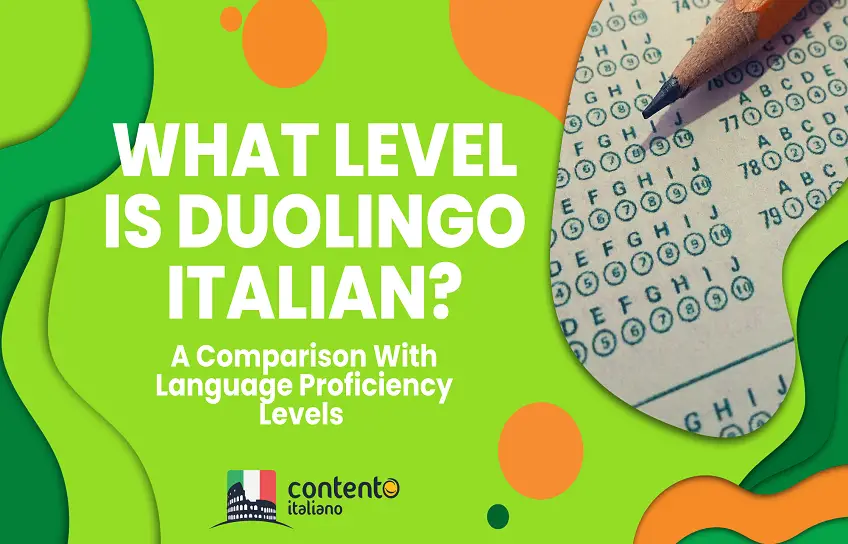
Table of Contents
What level are the duolingo italian lessons, how does the duolingo italian course relate to language proficiency levels, how advanced is the duolingo italian course, can the duolingo italian course make me proficient, which italian tenses will i learn in duolingo italian, is the duolingo italian course suitable for beginners.
Proficiency in a language is often classified according to the Common European Framework of Reference for Languages (CEFR) . Within the framework, there are six levels of proficiency. These are:
- A1 Beginners
- A2 Elementary
- B1 Intermediate
- B2 Upper Intermediate
- C1 Advanced
- C2 Proficiency
The Duolingo Italian course is divided into four sections ( click here to find out about number of lessons, crowns, skills, levels, etc… ).
In the table below, we have summarized the contents of the Duolingo Italian lessons within each section of the Duolingo Italian tree. We have also related the level of each Duolingo section to the European Framework for language proficiency.
This should help you to gain an understanding of what each section of the Duolingo Italian course will cover and what level of language proficiency you could expect to achieve from it.
How many of these questions can you get right?
(answers with explanations show here after you press submit).

Time's up
The contents of the Duolingo course can only be very loosely related to CEFR levels. This is because each of the CEFR levels for Italian (A1, A2, B1, B2, C1, C2) is very much focused on conversational aspects, such as being able to exchange information about a variety of matters with another person and being able to hold a conversation on both practical and abstract subjects.
On the other hand, due to being an app, Duolingo’s ability to teach conversational Italian is very limited.
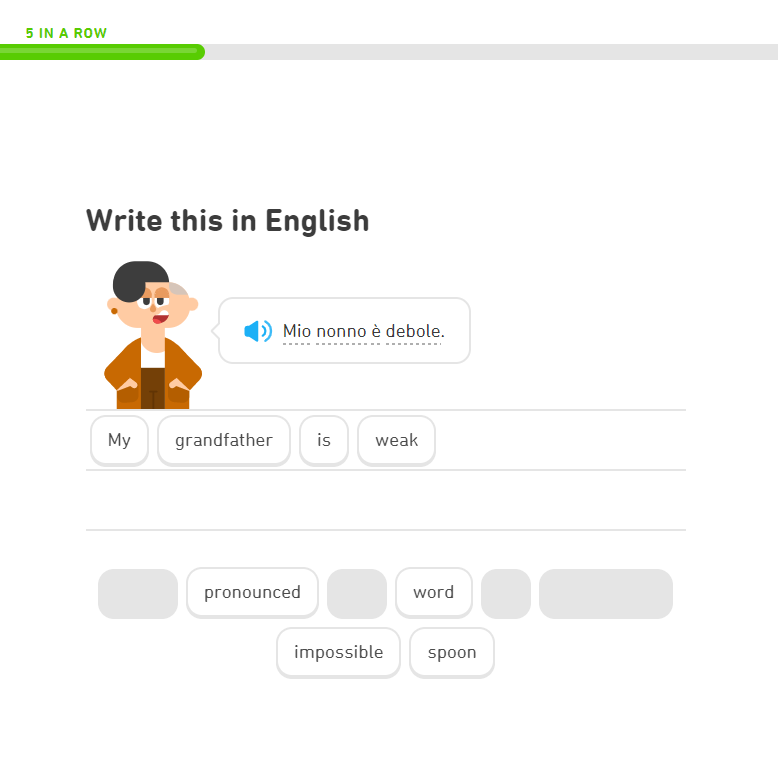
A scientific study found that the language proficiency gained by completing seven units of the French or Spanish courses in Duolingo was equivalent to four semesters of University study for reading and listening skills. Interestingly, the study was around reading and listening skills only, but did not focus on speaking skills.
Although the Italian Duolingo course covers a lot of material in a small number of sections , it is unlikely for a student to become fluent in Italian by using Duolingo alone.
The Duolingo Italian course packs a lot of complex grammar topics within its four sections , and therefore could be considered to teach up to an advanced level in Italian . However, it is very unlikely that someone could become proficient in Italian by using Duolingo alone.
Here are two examples of very advanced topics:
- The subjunctive mood (present and perfect tense) (Duolingo section 4)
The subjunctive is an extremely complex topic to understand, particularly for English speakers, because no such verb mood exists in English.
The subjunctive mood is used for verbs which are within subordinate clauses, like in the sentence “I don’t know if she has arrived”, where “if she has arrived” technically requires the subjunctive mood in Italian because it is a subordinate clause to “I don’t know”.
In practice, there are many instances where native Italian speakers themselves replace the subjunctive mood with the indicative mood, particularly in spoken Italian.
The subjunctive mood is becoming increasingly less used in spoken Italian, so a learner of Italian should learn this mood gradually and not worry about being incorrect if they avoid using it until they feel comfortable doing so.
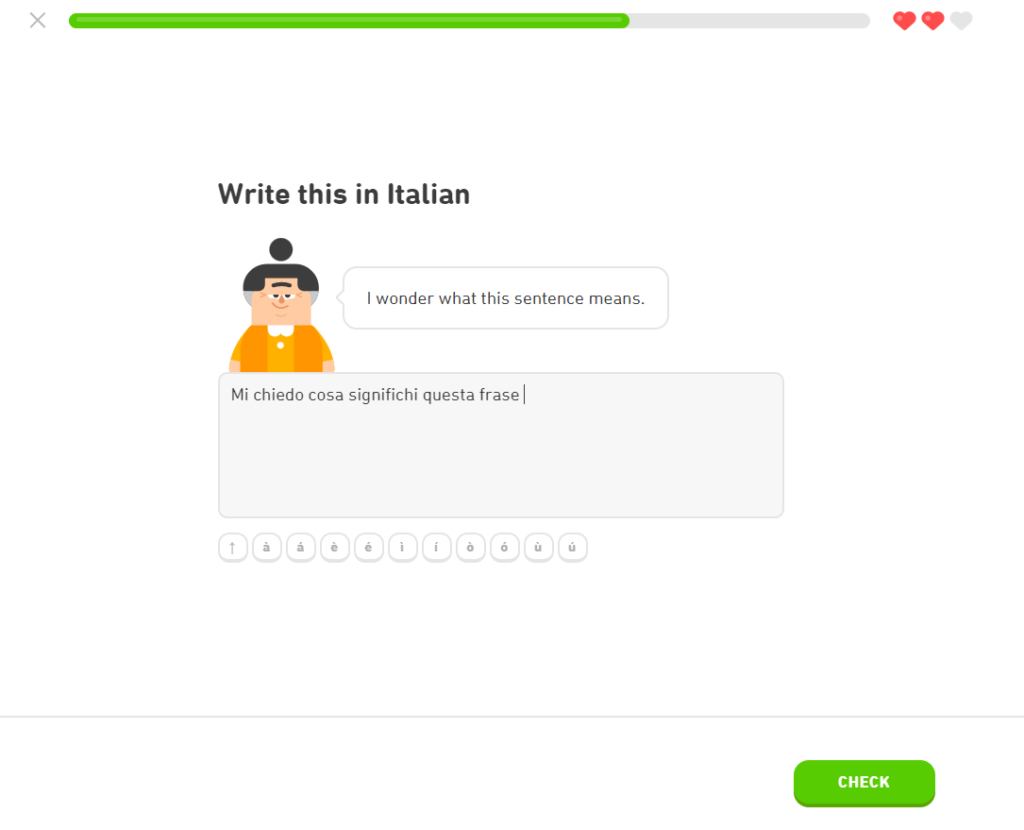
By focusing too much on the Italian subjunctive mood, there is a risk of discouraging the learner and making their learning experience too much of a memory exercise, with them having to memorize yet another tense.
- The preterite past tense (Duolingo section 4)
In today’s Italian, the preterite past tense is confined to written language, and found mainly in novels and essays. The Duolingo Italian course teaches this tense, although you won’t need it in spoken Italian. It is useful to understand that it exists, however, and to be able to understand it if you are planning on reading Italian literature.
The fact that Duolingo packs a lot of grammar in a short course can leave learners of Italian feeling discouraged and frustrated about learning, and can foster the belief that Italian as a foreign language is too difficult to master.
When taken in isolation, some of the grammar topics dealt with in the Duolingo Italian course could be considered to be at level C1 and C2. They are highly complex topics and take time and practice to master. Examples are, the subjunctive mood, the preterite past tense, clitics and correct use of modal verbs.
Despite the density of grammar topics in Duolingo, it is unlikely that you will attain proficiency in Italian to genuine C1 or C2 level by completing the Duolingo Italian course alone, although Duolingo does give you a good general introduction to Italian, up to upper intermediate/ advanced level.
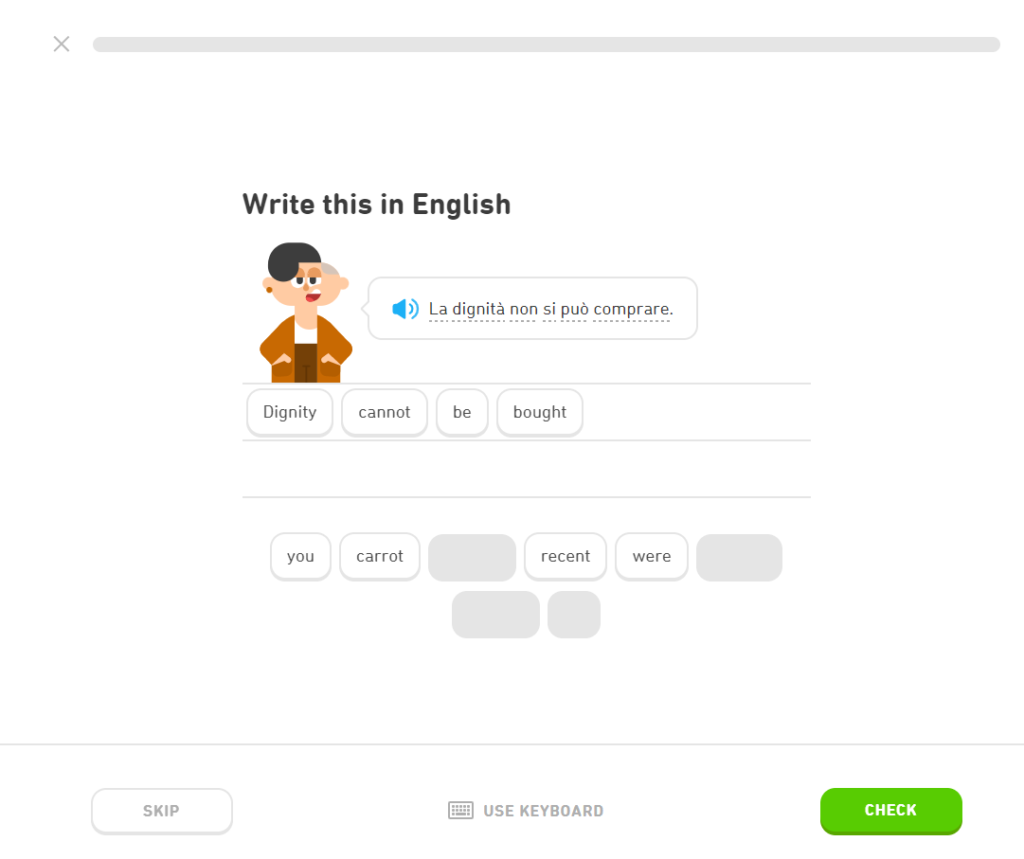
The Duolingo Italian course teaches the following tenses …
- Present tense
- Present perfect
- Imperfect tense
- Past perfect
- Future tense
- Future perfect
- Preterite past
… and the following moods:
- Conditional
- Subjunctive
The Duolingo Italian course is suitable for beginners through to advanced learners so if have no background in Italian at all, Duolingo is a very good place to start.
Section 1 and Section 2 of the Duolingo Italian tree are at beginner level, progressing to intermediate / advanced in Sections 3 and 4. Duolingo will not allow you to progress to the higher levels unless you have completed the lower levels.
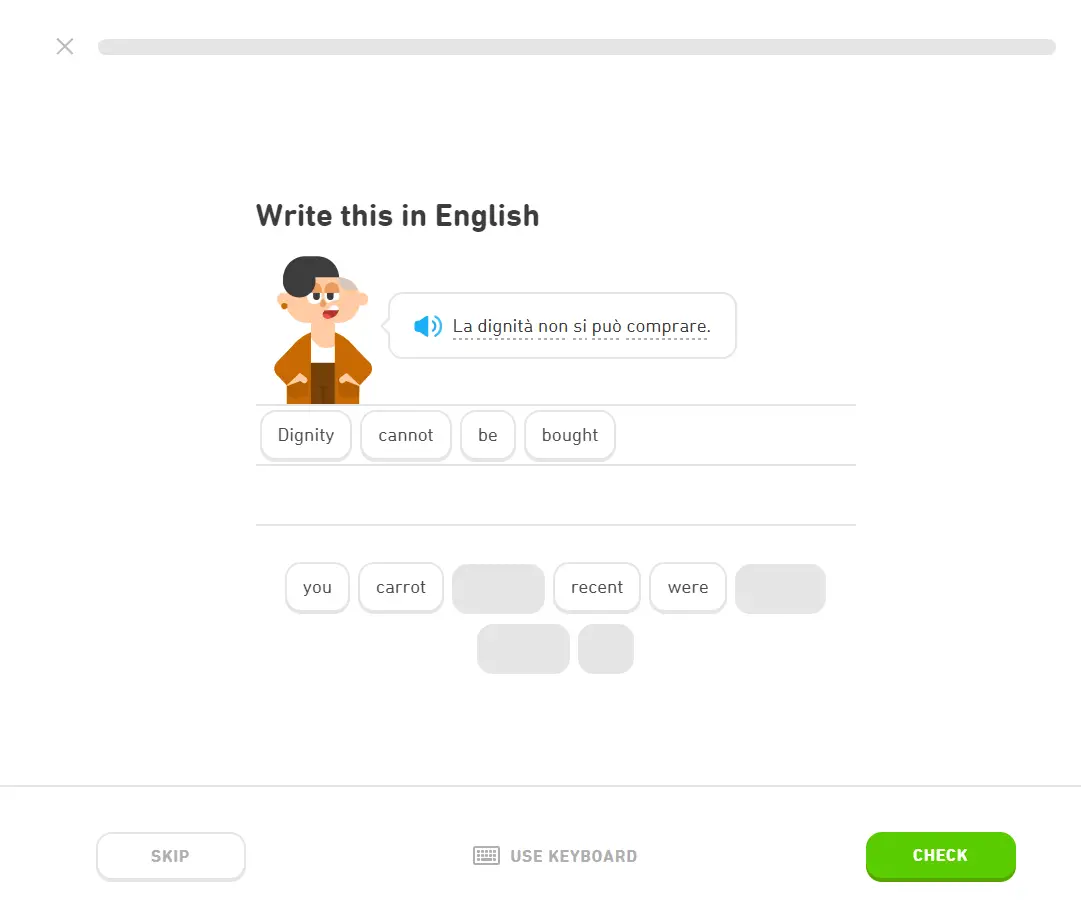
Related Posts

Does Latin Sound Like Italian?
You may have wondered if Latin sounds like Italian, and whether someone with no knowledge of Italian would be able to tell the two languages apart just based on how they sound. Overall, Latin sounds…
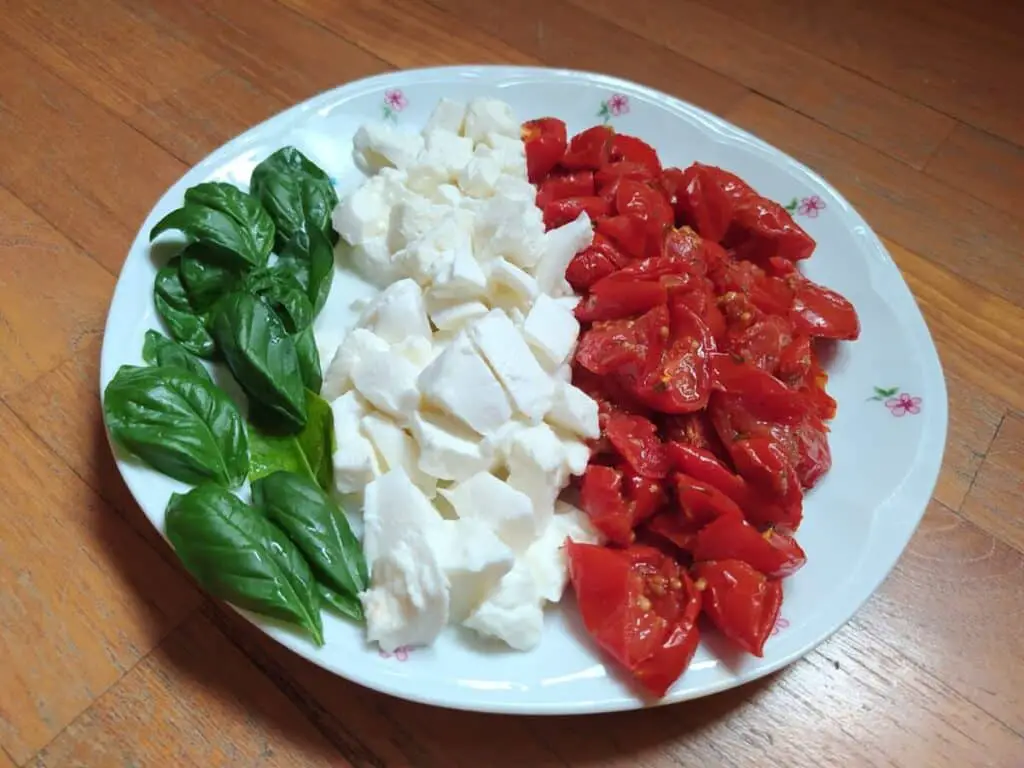
Italian Accents Compared: Which Is Best?
If you are interested in the Italian language, you might know that Italian is spoken in several different accents depending on the area. You may have wondered what is the best Italian accent? For example,…

Six Reasons Why You Should Learn Italian
Is it useful to learn Italian? Learning Italian is useful for a number of reasons, including opportunities to use Italian, benefits to your personal development and health, giving you the ability to go on holiday…

Is Learning Italian Easier Than French? – Find Out From Two Experts Who Learned Both Languages
If you are thinking of learning a new language and are wondering whether French or Italian is easier I have the answer for you. During my childhood and teenage years in Italy I studied French…

Duolingo Review - Does It Actually Work? | 2024 (with Product Images)
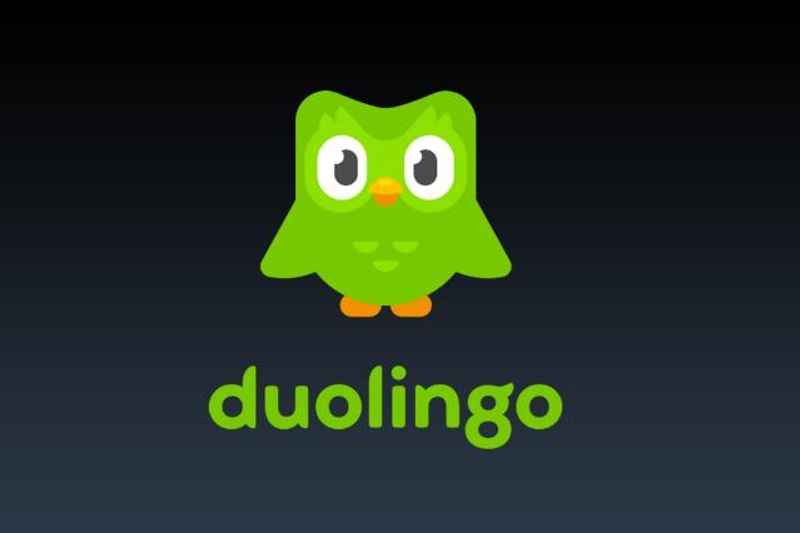
Designed to make the language learning process not just easily accessible but enjoyable and a source of fun, Duolingo was unveiled to the public in 2012 and has skyrocketed to more than 300 million registered learners of 38 languages.
Today, in this Duolingo review, we’ll be taking you on a guided tour through everything that Duolingo has to offer you, whether you’re an amateur linguist or a full-blown polyglot.
As a friendly and functional app with an eye-catching design and an adorable (if intimidating) mascot, many have found it a wonderful first step into the world of language learning or offering great opportunities to practice existing abilities.
Despite being absolutely free to use (with upgrades and extras available by way of subscribing to a premium membership - more on that later) you’ll notice it still ranks highly against even some of the most expensive competing apps and software.
Finally, remember that this is just one of the hundreds of language resources that we have put together or reviewed. Let’s get right into it.
Unlocking Language Skills on the Go: Duolingo for Travelers
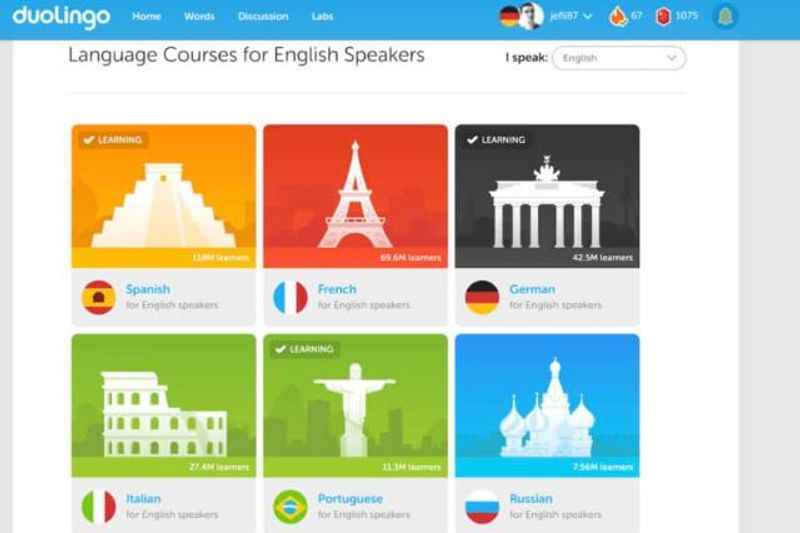
Duolingo, the travel-centric language learning app, caters to globetrotters seeking to unlock a world of communication possibilities.
With its user-friendly interface, extensive language options, and gamified approach, Duolingo is a valuable tool for travelers of all levels .
Whether it's ordering food, navigating unfamiliar streets, or engaging in simple conversations, the app equips users with practical language skills for real-life travel scenarios .
With flexible learning goals and bite-sized lessons, Duolingo fits seamlessly into busy travel schedules.
By focusing on listening and speaking exercises, it helps travelers improve their language proficiency and connect with locals on a deeper level.
Start your language learning journey with Duolingo and enhance your travel experiences today.
Duolingo Review: Quick Pros and Cons

Surely you first want to know about the pros and cons of this app.
- A smooth, easy-to-use interface that’s manageable for tech newbies
- Continuous motivational features including your daily streak, the life system, XP, badges, and in-game currency
- Makes education fun and competitive with a series of entertaining tasks, lessons, and skills
- The weekly users league allows you to compete with friends and strangers and rank up when you do well
- Returns to old lessons and reminds you of existing knowledge - follows a spiral syllabus
- Some language courses are longer and more fleshed out than others
- Premium membership is needed to access certain features, including offline practice
- Lessons can be repetitive
While there are a few cons to consider, the numerous pros of Duolingo outweigh them. We first highlighted the smooth interface, motivating features, and entertaining tasks that make language learning fun.
Additionally, the ability to compete with others in the weekly league adds an element of excitement. Duolingo's practice of revisiting old lessons and reinforcing knowledge follows a spiral syllabus, ensuring comprehensive learning.
Although some courses may have more content, the overall user experience and benefits make Duolingo an excellent choice for language learners. Additionally, while certain features require a premium membership, the free version still offers substantial value.
Getting Started - What Languages Are Available To Learn

English speakers looking to learn a new language - rejoice! There are over thirty at your disposal, so there’s bound to be one that tickles your fancy. Feast your eyes:
- High Valyrian
- Klingon (beta)
- Mandarin Chinese
- Navajo (beta)
- Norwegian Bokmal
- Scottish Gaelic
Other Duolingo Languages
Unlike many competing language learning tools, Duolingo also caters to speakers with first languages other than English , albeit in a more limited capacity. These include:
- English , in Arabic, Chinese, Czech, Dutch, French, German, Greek, Hindi, Hungarian, Indonesian, Italian, Japanese, Korean, Polish, Portuguese, Romanian, Russian, Spanish, Thai, Turkish, Ukrainian, and Vietnamese
- Mandarin Chinese , in Japanese
- Esperanto , in Spanish, French, and Portuguese
- French , in Arabic, Chinese, Dutch, German, Italian, Portuguese, Russian, and Spanish
- German , in Arabic, Dutch, French, Italian, Portuguese, Russian, Spanish, and Turkish
- Italian , in Chinese, French, Portuguese, and Spanish)
- Japanese , in Chinese
- Korean , in Chinese
- Brazilian Portuguese , in French and Spanish
- Russian , in Spanish, and Turkish
- Spanish , in Chinese, French, German, Italian, Portuguese, and Russian
- Swedish , in Arabic and Spanish
Spanish, French, Italian, and Portuguese are popular choices for travelers due to their wide usage and practicality. These languages can greatly enhance travel experiences as they are commonly spoken in various regions around the world.
On the other hand, languages like Mandarin Chinese, Arabic, and Russian may be more challenging for learners due to their complex writing systems or grammatical structures.
However, with Duolingo's engaging lessons and practice exercises, even these more difficult languages become accessible to motivated learners, opening doors to unique cultural interactions during travels.
Even if you are traveling to a country where English is widely spoken, natives always appreciate the time and effort you put into learning their language and culture. It is a sign of respect and your travel will be much smoother if you learn a bit.
The Most Popular Language on Duolingo in 2024
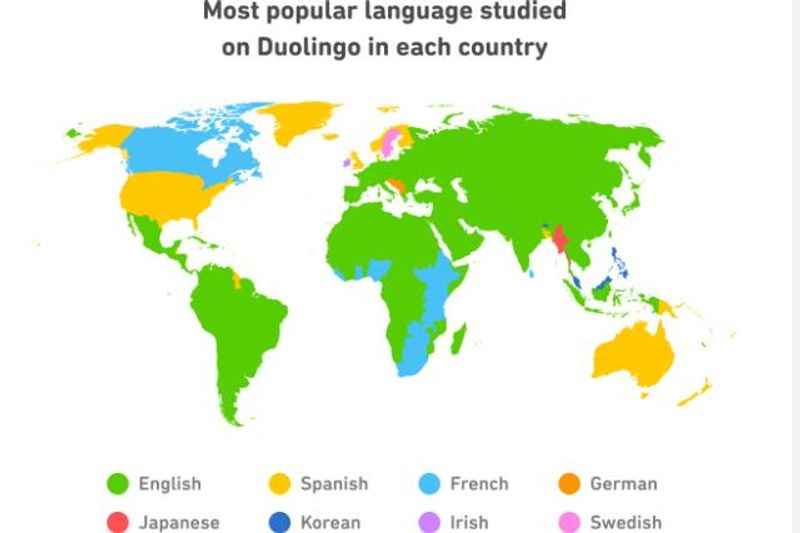
Duolingo offers a wide range of language courses, but one language stands out as the most popular among its users: Spanish. With its widespread global use and cultural influence, it's no surprise that many language learners flock to Duolingo's Spanish course.
The popularity of Duolingo Spanish can be attributed to several factors. First, Spanish is one of the most widely spoken languages in the world, making it a practical choice for both travel and business purposes.
Additionally, Spanish is known for its beautiful melodic sound, which adds to its appeal.
Duolingo's Spanish course is designed to cater to learners of all levels, from beginners to advanced. The curriculum covers essential vocabulary, grammar, and conversational skills, enabling learners to communicate effectively in everyday situations.
The interactive lessons, engaging exercises, and audio recordings help users develop their listening, speaking, reading, and writing skills.
Moreover, Duolingo's gamified approach keeps learners motivated and encourages daily practice. The platform's user-friendly interface and intuitive design make it accessible and enjoyable for learners of all ages and backgrounds.
Whether users are starting from scratch or looking to refine their existing Spanish skills, Duolingo provides a valuable resource. Learners can track their progress, earn rewards, and even connect with a community of fellow Spanish learners.
The popularity of Duolingo Spanish is a testament to its effectiveness and the app's ability to make language learning engaging and accessible to a wide audience.
Duolingo Review: The Basics
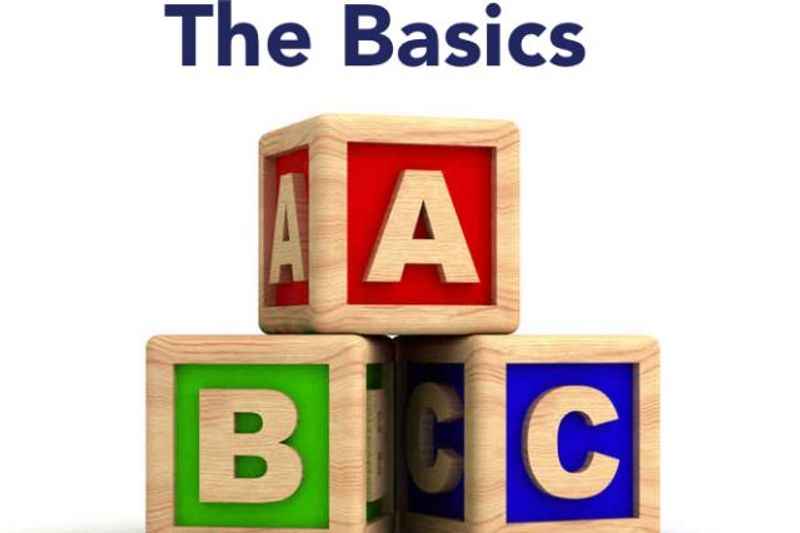
First things first, you’ll need to download the app (available on all Android and Apple devices) or head to the website and register yourself for an account. All that remains is to choose your language, and there’s a lot to pick from, as you saw.
Next, pick your daily learning goals - do you want to achieve five minutes a day, fifteen, or maybe more? It’s up to you, and you can increase or decrease your current goal at any time, so no need to panic if you’ve made things too easy or hard.
Either start from scratch as an absolute beginner or take their handy entrance quiz if you feel like you have some useful existing experience. You’ll be placed at a point in the course that suits you - but don’t worry, you can always go back to the start!
Then, you’re introduced to its iconic learning map - separated into modules, which are presented in numerical order, you’ll cover a variety of topics ranging from themes (like food or entertainment) to grammar (such as tenses and conjunctions).
How Does the Course Work?
Although you can - and are largely encouraged to - return to earlier lessons and practice old content, you move through the course chronologically. It isn’t possible to move on to later classes until you’ve successfully completed those that come before.
Every module is divided into individual levels, which you can test out of if you feel like you’ve learned enough or you’re already familiar with its content. This is useful as an intermediate learner - you must successfully pass the test to move on, though!
For beginners, this is a beautiful way to start learning a language, as you can get stuck into your learning in just a couple of minutes, already coming away with around ten or twenty new vocabulary words you didn’t learn before at the end of day one.
Everything is designed in bright colors, with clear fonts, adorable digital drawings, and accompanying images - the software is intuitive and it is very much obvious what you’re being asked to do or where you need to go at every stage of play.
What Makes Duolingo Great - Key Features
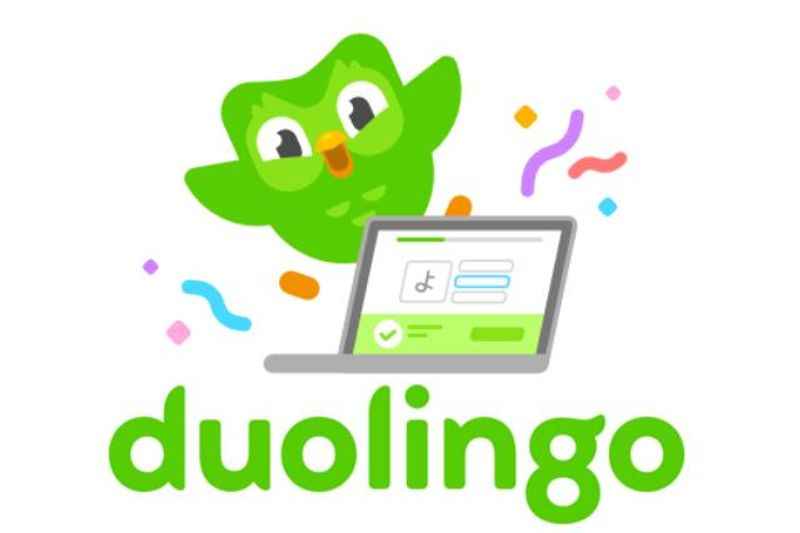
One of the best things about Duolingo is its constant motivation of the user. It does this in several different ways, each an important facet of its widespread success - let’s talk about them:
Very much reflective of a video game, Duo users start every day with five “hearts” which serve as their “lives” in the game - by failing to successfully complete an exercise, you will lose one of those hearts, and it won’t refill for a couple of hours. This is one aspect that makes several Duolingo reviews so positive.
If you’ve played Candy Crush Saga, it’s similar to that system - once you’ve run out of hearts, that’s it; you need to wait until that clock runs down to replenish your lives and play again. Unless… you spend some more money on a premium membership.
The desire to keep those lives intact so you aren’t interrupted mid-session works to keep you trying your best on every exercise, thereby improving your overall learning by encouraging you to think more carefully about your answers and retain that information.
When you first join Duolingo and successfully complete a lesson, you’ll begin right at the start in the Bronze League, added to a leaderboard with 30 other brand-new players to compete for the coveted top spot and level up to the next league.
To do this, all you need to do is practice! Finishing each lesson nets you some valuable XP, which are the points that move you up in the league - stay ahead of your fellow players and keep your position in the top ten to be upgraded.
Beware! If you are at the very bottom of your league, you run the risk of being demoted back again at the end of the week.
Completing an exercise will also net you lingots, which are tiny little gems serving as the game’s currency - you are awarded these at various points throughout the language learning experience, and they can be used to buy a number of bonuses.
You’ll earn lingots for completing a ‘skill’ for the very first time, successfully reaching your daily goal, leveling up to the next XP rank, maintaining your streak, inviting friends to the game, or finishing the week’s league in first, second, or third position.
Things you can spend your hard-earned lingots on include: bonus skills, power-ups, and streak freezes (those get mighty important once you get past your first few weeks of play, you have my word… there is no better feeling than hitting a 100+ streak!)
Now, this is a big one - every single day that you play even just one lesson, you keep your existing streak alive and add another day to your journey. Miss just one day and all of that hard work disappears up in smoke… there’s nothing you can do!
Sure, if you’ve only been playing a day or two this isn’t too big of a deal, but imagine forgetting about over a hundred days, or even a thousand… the devastation just isn’t worth considering, so always stay stocked up on streak freezes using your lingots.
By upgrading to a premium account you also get access to one free streak freeze a month, in addition to unlimited lives. If you’re scared of losing out or messing up, that upgrade is probably worth your while, just to save you some unnecessary stress!
Achievements
These aren’t quite as exciting, but they can be great markers of your progress, as well as awarding you some valuable XP and lingots when you unlock each one - represented by badges, there are many to achieve, each with its own set of tiers.
These achievements or badges are unlocked after you’ve completed a certain amount of tasks or a specific action and will differ slightly depending on whether you use Android or Apple software or are learning via the web.
Fun nicknames you will be given as a result of these successful completions include Wildfire, Weekend Warrior, Champion, Conqueror, Scholar, Sage, and Challenger - it sounds pretty badass and it makes you feel pretty smart, too.
Are There Any Potential Downsides?

Unfortunately, when it comes to the potential for practicing your speaking skills, there’s not that much available on Duolingo. Although you can toggle speaking exercises on and off, you’re either reading things aloud or repeating a phrase from an audio clip.
In a similar vein, a lot of Duo’s language courses tend to only accept one very strict answer for translations, which fails to acknowledge the wide variety of dialects and different meanings that can impact a word’s spelling, pronunciation, and meaning.
This means that your focus is on gaining vocabulary and forming sentences rather than learning to speak coherently and have a fluent conversation with a native speaker or other learners - this is where services like Italki can be better.
Similarly, we’d also recommend Rosetta Stone over Duo for a more immersive language learning experience, that constantly has you listening to native speakers and practicing your own speaking or pronunciation skills as a focal point of your learning.
Although it can seriously bolster your learning, Duolingo is never going to be enough to get you speaking a language fluently, primarily because of the downsides we’ve listed above - you can practice, but you’ll get very little by way of real-time feedback.
Guide Through Duolingo: What Does a Duolingo Lesson Look Like?
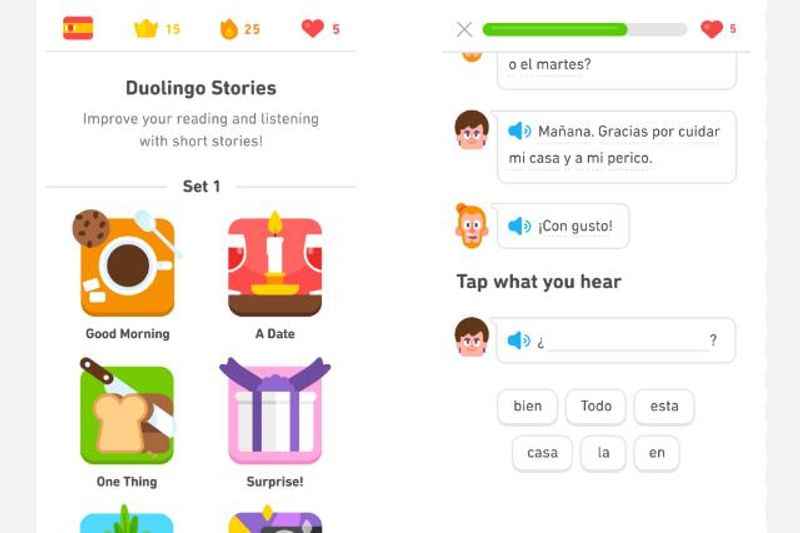
Duolingo, the popular language-learning platform, offers an engaging and effective learning experience. If you're curious about what a Duolingo lesson entails, let's take a closer look.
To get started, create a user account on the Duolingo website or mobile application. Once logged in, you'll be prompted to select the language you want to learn.
Don't worry; you can add more languages later. A short tutorial will introduce you to the different types of questions Duolingo uses.
The Language "Skill Tree"
Each language on Duolingo is represented as a "skill tree." New users start at the top of the tree and work their way down. Every skill contains a series of lessons that focus on specific language aspects.
Completing one lesson unlocks the next. You can repeat lessons if you need more practice.
Inside Duolingo Lessons
- Duolingo lessons consist of various exercises designed to enhance your language skills.
- Translation exercises present sentences for translation between languages.
- Listening exercises require you to listen to a sentence and type it out.
- Speaking exercises allow you to practice speaking into your device's microphone.
New Vocabulary Hints
Translation exercises introduce new vocabulary and grammar.
Duolingo highlights unfamiliar words and phrases in yellow, providing hover-over hints with possible translations. This helps expand your vocabulary and solidify your understanding.
If at First, You Don't Succeed...
Making mistakes is part of the learning process. If you answer an exercise incorrectly, Duolingo provides the correct answer and rewards you with points when you complete it.
You can retry lessons as many times as needed until you pass them.
Remember Me?
To reinforce what you've learned, Duolingo helps you retain knowledge with the Practice button. This feature prompts you to review previously learned material, ensuring it sticks in your long-term memory. You can also practice specific lessons or skills using the Practice button within each skill.
As you progress, your level increases. Starting at level one, your level keeps growing until it reaches 25. Your profile displays your current level, reflecting your language proficiency.
But Wait, There's More!
Duolingo offers additional perks beyond language learning.
As you achieve milestones, such as completing all lessons in a skill or practicing for consecutive days, you earn lingots. This virtual currency can be spent on language and owl-themed items in the Lingot store.
Additionally, completing all the skills in a language tree earns you a special virtual trophy, recognizing your achievement.
The Duolingo Community
Learning on Duolingo doesn't mean learning alone. You can connect with other learners in the Duolingo discussion areas.
Compete with friends, interact with fellow learners, and share your progress. Duolingo provides a supportive community to enhance your learning experience.
Duolingo is a Language App for On-the-Go Learning
Duolingo is available as a mobile app for iOS and Android devices, in addition to the website.
You can seamlessly switch between platforms using the same user login to learn the vocabulary of your chosen language or languages.
A Duolingo lesson consists of a series of exercises focused on different language skills. From translation to listening and speaking, Duolingo provides a comprehensive language learning experience.
The gamified approach, vocabulary hints, and progress tracking make learning engaging and rewarding.
With Duolingo, you can embark on an exciting language learning journey, whether you're a beginner or aiming for advanced proficiency.
Let's Talk About the Owl

Duolingo's design is characterized by its simplicity and charming aesthetics, which greatly contribute to the overall learning experience. The app's interface is clean, intuitive, and visually appealing, making it accessible to learners of all ages.
The use of bright colors, friendly illustrations, and an adorable mascot, the green owl, creates a welcoming and engaging environment for users.
The simple design of Duolingo allows learners to focus on the content and tasks at hand without being overwhelmed by unnecessary distractions. The clear fonts and intuitive navigation make it easy to understand instructions and progress through the lessons.
The straightforward layout ensures that learners can navigate the app effortlessly, whether they are accessing it on a computer or a mobile device.
The cute and endearing design elements of Duolingo play a significant role in enhancing the learning process. The friendly illustrations and the presence of the green owl mascot create a sense of companionship and motivate learners to continue their language journey.
The visual appeal of the app makes users comfortable and evokes positive emotions, making language learning a fun and enjoyable experience.
Furthermore, the combination of simplicity and cuteness in the design helps to alleviate any potential anxieties or apprehensions that learners may have about tackling a new language.
The welcoming design promotes a relaxed and comfortable atmosphere, encouraging learners to approach their language studies with enthusiasm and confidence.
So, Duolingo's simple and cute design is more than just visually pleasing. It enhances the learning process by providing a user-friendly interface, minimizing distractions, fostering positive emotions, and creating a supportive environment.
With its thoughtful design, Duolingo successfully combines aesthetics and functionality to create an enjoyable language learning experience for users of all ages.
Is Duolingo Plus (Super) Worth It - Should You Get Premium Membership?

No Duolingo review would be complete without answering this question. Beginning its journey as an absolutely free app, and pledging that would always be the case, Duolingo does not require a paid membership.
It is primarily supported by ads - to get rid of those and also access a couple of bonus features, you can pay $6.99 per month for Duolingo Plus, their premium subscription service.
Whether this is a worthwhile investment for you depends on several factors, perhaps most importantly your financial situation. If a regular subscription fee is outside of your budget then don’t worry too much about it: the only thing you’re missing out on is the chance for “unlimited hearts” and one free streak freeze per month.
Those are certainly useful features, but they won’t inhibit your language learning.
Plus, if you opt for using the online web edition (or if you have run out of hearts in the app but don’t want to stop practicing…) then you don’t need to worry about lives at all, as they aren’t a part of the program when accessed via a browser.
That being said, if you do have the funds to pay for a membership, enjoy and appreciate the service that Duolingo provides, and would like to support the developers financially, then you absolutely should.
They do a brilliant job and this will help keep the app free for those who truly need it.
Duolingo for Kids
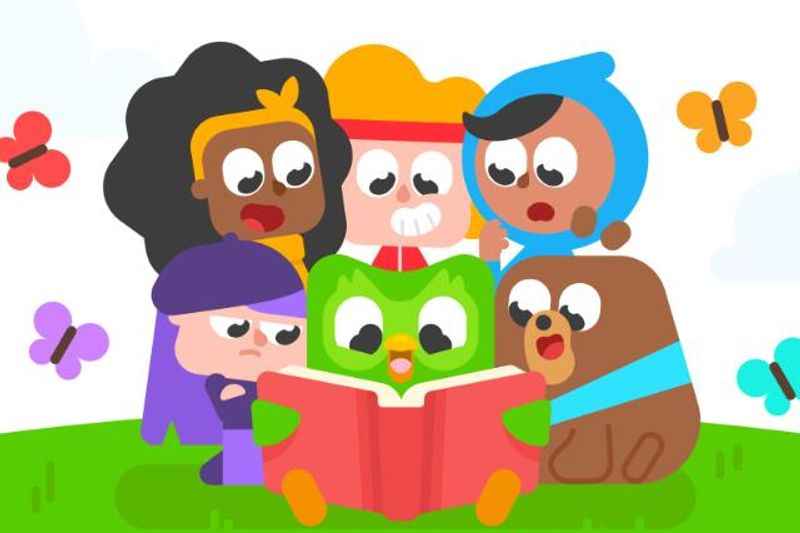
Duolingo, renowned for its language learning prowess, also offers a dedicated platform for children to learn a language.
This specialized version of the app opens up a world of benefits for young learners, providing a fun and engaging environment to develop language skills. Here, we explore the advantages and features of Duolingo for Kids and how it positively influences children's language learning journey.
One of the key benefits of Duolingo for Kids is its ability to target language learners at an early age. In short - Duolingo lessons are fun. By introducing them to the target language in a playful and interactive way, Duolingo sparks children's curiosity and enthusiasm for learning.
The app offers a wide range of language courses tailored specifically for young learners, covering popular languages such as Spanish, French, and German, or any other languages they choose.
Duolingo for Kids encourages the development of speaking skills through its voice recognition technology. Children can practice pronunciation and engage in speaking exercises, helping them build confidence in their oral communication.
This feature enables them to hear and imitate native speakers, developing an authentic accent and intonation from an early stage.
The gamified nature of Duolingo for Kids makes language learning enjoyable and engaging. With colorful visuals, playful characters, and interactive exercises, the app captivates young learners' attention, motivating them to progress and achieve goals.
Duolingo's gamification elements, such as earning badges and completing levels, provide a sense of accomplishment and reinforce a positive learning experience.
The structured language courses in Duolingo for Kids ensure a well-rounded learning journey. Lessons cover various language skills, including reading, writing, listening, and speaking. By engaging with diverse exercises, children develop a strong foundation in vocabulary, grammar, and sentence structure.
The app also offers listening exercises to enhance comprehension skills, enabling kids to understand spoken language effectively.
Duolingo for Kids offers a safe and child-friendly learning environment. The app employs a simple and intuitive interface, ensuring ease of use for young learners.
Additionally, Duolingo prioritizes the privacy and security of its users, providing a trustworthy platform for children to explore and learn.
Furthermore, Duolingo for Kids fosters the development of essential cognitive skills. Research has shown that early exposure to language learning positively influences memory, problem-solving abilities, and critical thinking.
By immersing children in a language-rich environment, Duolingo supports their overall cognitive development and opens doors to future opportunities.
Duolingo for Kids is a remarkable language learning app that empowers young learners with the tools and motivation to develop language skills. Through its engaging and interactive platform, Duolingo sparks children's interest in language learning and nurtures their linguistic abilities.
By combining educational content, gamification, and a safe learning environment, Duolingo for Kids lays the foundation for a lifelong love of languages and provides children with valuable language skills for their future endeavors. Learning languages has never been so easy for your kids.
Duolingo For Adults and Seniors
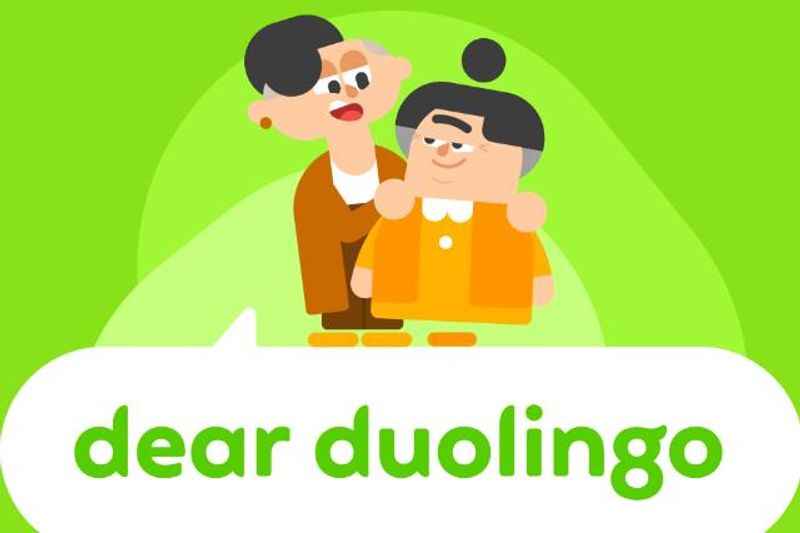
As seniors embrace their golden years, many discover a newfound passion for travel and exploration. Whether it's visiting iconic landmarks, immersing in diverse cultures, or connecting with people from around the world, travel offers endless opportunities for enriching experiences.
Duolingo, the popular language learning app, can be an invaluable tool for seniors looking to make the most of their adventures.
Language learning has numerous benefits for seniors, including cognitive stimulation, memory enhancement, and improved problem-solving skills.
Duolingo offers a user-friendly platform that caters to learners of all ages, making it an ideal choice for seniors embarking on their language learning journey.
One of the key advantages of Duolingo for seniors is its flexibility. With bite-sized lessons and the ability to set individual learning goals, seniors can tailor their language learning experience to fit their schedule and pace.
Whether it's dedicating a few minutes each day or diving into more extensive study sessions, Duolingo allows seniors to learn at their own convenience.
Duolingo offers a wide range of languages, including popular choices for travelers like Spanish, French, German, Italian, and more. Seniors can select their target language and embark on a virtual journey of language acquisition.
From basic greetings to conversational phrases and essential vocabulary, Duolingo's curriculum covers all the necessary elements to communicate effectively while traveling.
The app's interactive exercises, including listening comprehension and speaking exercises, provide seniors with opportunities to practice their language skills in a supportive environment. Seniors can enhance their pronunciation, develop their listening abilities, and gain confidence in their speaking skills.
While the app's speaking exercises might not be perfect, they still offer valuable practice and a chance to improve conversational abilities.
Moreover, Duolingo's gamified approach makes language learning engaging and fun. Seniors can earn points, unlock achievements, and track their progress as they advance through the lessons.
This sense of accomplishment and progression can be particularly motivating for seniors, encouraging them to continue their language learning journey with enthusiasm.
Another significant advantage of Duolingo for seniors is its accessibility. The app can be accessed on various devices, including smartphones, tablets, and computers, allowing seniors to learn on the go or from the comfort of their own homes.
Additionally, Duolingo's free version provides a wealth of learning resources, making it an affordable choice for seniors on a budget.
Language Learning for Travel Enthusiasts
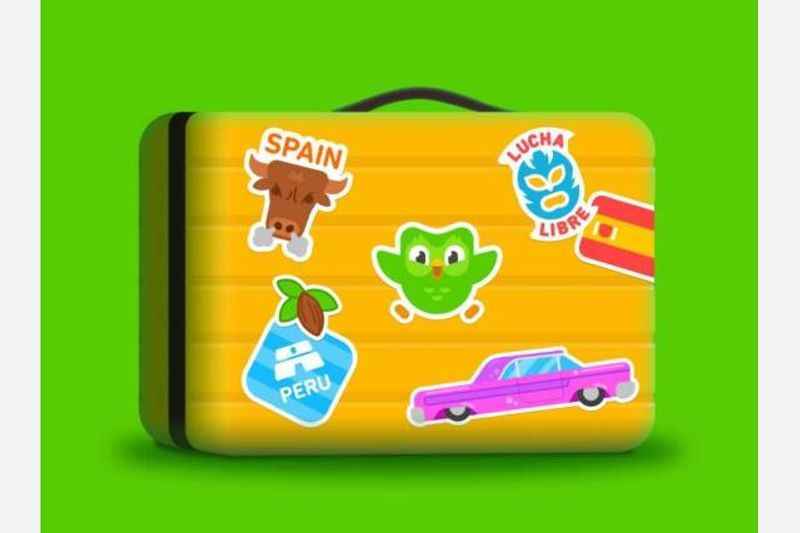
Learning a new language with Duolingo opens doors to cultural experiences, deeper connections with locals, and a greater appreciation for the destinations you visit.
It enhances the travel experience by enabling you to navigate foreign lands, interact with locals, and immerse yourself in everyday conversations.
From ordering food at a local cafe to asking for directions, speaking a few phrases in the local language can create memorable moments and foster genuine connections.
As you can see, Duolingo offers an accessible and engaging platform to learn languages for your travel adventures, no matter how old you are.
It provides flexibility, comprehensive language lessons, and a gamified learning experience that appeals to children, adults, and seniors' curiosity and sense of achievement.
With Duolingo, you can embark on a language-learning journey, enrich your travel experiences, and create lasting memories as you explore the world around you.
Other Language Learning Apps You Should Know About
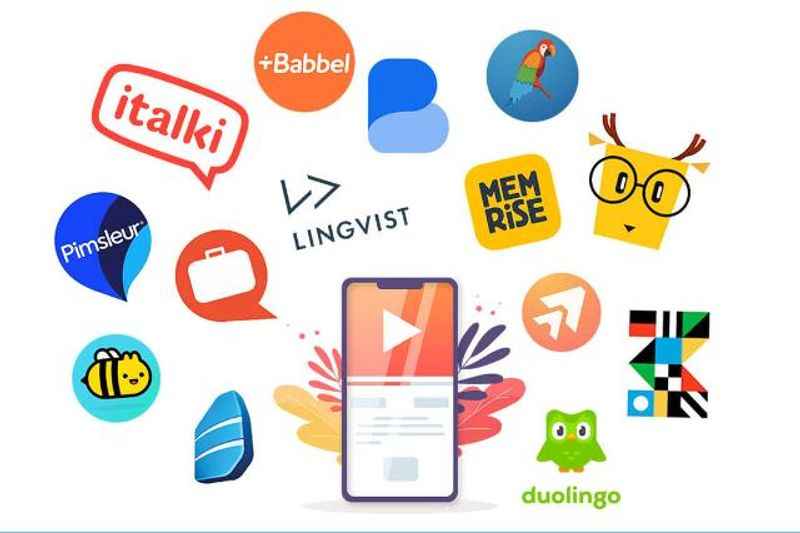
When it comes to language learning apps, Duolingo stands out as a top choice for several reasons.
While there are other similar apps available, Duolingo offers a unique combination of features that make it a preferred option for language learners.
Here, we will explore five similar apps and compare them to Duolingo.
1. Rosetta Stone
Known for its immersive language learning experience, Rosetta Stone provides comprehensive lessons and emphasizes speaking skills.
However, it comes with a hefty price tag, making it less accessible for budget-conscious learners compared to Duolingo's free version.
Babbel offers a variety of language courses with a focus on practical conversation skills. If you want to focus on speaking skills, Babbel is a great supplementary resource.
While it provides quality content, it requires a subscription fee, whereas Duolingo offers language learning progress for free.
Memrise combines spaced repetition and mnemonic techniques to aid in vocabulary acquisition. It offers a range of user-created courses, but its focus on memorization might not provide the same depth of learning as Duolingo's comprehensive curriculum.
4. HelloTalk
HelloTalk connects language learners with native speakers for language exchange.
It's a great platform for practicing speaking skills, though it lacks the structured lessons and comprehensive content that Duolingo provides.
Busuu offers interactive lessons and language courses, along with opportunities for feedback from native speakers.
However, it requires a subscription for full access, limiting its appeal compared to Duolingo's free and accessible approach. Feel free to check our in-depth Busuu and Duolingo comparison .
Other Apps VS Duolingo
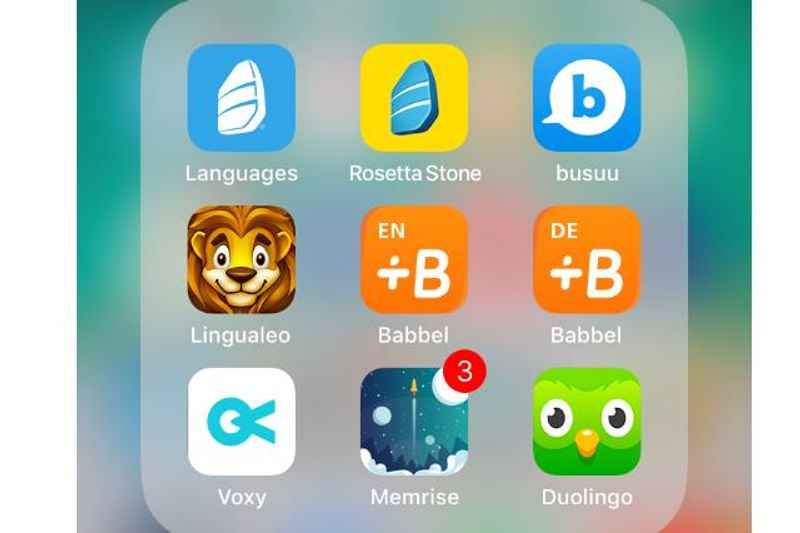
While these apps have their merits, Duolingo remains the top choice for the majority of global language learners. It offers an extensive range of language courses, caters to various proficiency levels, and follows a structured curriculum.
Duolingo's free version provides a remarkable value compared to the subscription-based models of many competitors. Whether you're a beginner or an intermediate learner, Duolingo offers a user-friendly platform to develop your language skills at your own pace and for free.
With its gamified approach, Duolingo keeps learners motivated and engaged throughout their language-learning journey. The app's emphasis on all four language skills—reading, writing, listening, and speaking—ensures a well-rounded learning experience.
That being said, the speaking is a little minimal and the listening lacks context.
You can report issues with Duolingo listening and speaking exercises, which is good, as it can be frustrating when an app asks you to repeatedly go over the same broken speaking exercise. However, such a large platform shouldn't really have mistakes in its exercises.
Comparing Prices
When it comes to learning a new language, there are several language learning apps available in the market. Let's take a closer look at five popular alternatives to Duolingo: Rosetta Stone, Babbel, Memrise, HelloTalk, and Busuu. We'll explore their pricing models and compare them to Duolingo.
- Rosetta Stone : Known for its immersive language learning experience, Rosetta Stone provides comprehensive lessons and emphasizes speaking skills. However, it comes with a hefty price tag. Rosetta Stone offers subscription plans starting at $11.99 per month, making it less accessible for budget-conscious learners compared to Duolingo's free version.
- Babbel : Babbel offers a variety of language courses with a focus on practical conversation skills. While it provides quality content, it requires a subscription fee. Babbel's pricing starts at $6.95 per month, which offers access to all language courses. In contrast, Duolingo provides language learning progress for free.
- Memrise : Memrise combines spaced repetition and mnemonic techniques to aid in vocabulary acquisition. It offers a range of user-created courses. While Memrise offers a free version, it also provides a paid subscription plan called "Memrise Pro" for $8.99 per month. However, its focus on memorization might not provide the same depth of learning as Duolingo's comprehensive curriculum.
- HelloTalk : HelloTalk connects language learners with native speakers for language exchange. It's a great platform for practicing speaking skills. HelloTalk offers a free version with limited features, but it also has a paid subscription plan called "VIP Membership" priced at $4.99 per month. However, it lacks the structured lessons and comprehensive content that Duolingo provides.
- Busuu : Busuu offers interactive lessons and language courses, along with opportunities for feedback from native speakers. It requires a subscription for full access, with prices starting at $9.99 per month. While Busuu provides a quality learning experience, its subscription model limits its appeal compared to Duolingo's free and accessible approach.
As you can see Duolingo stands out as a cost-effective option with its free version and comprehensive curriculum.
While other apps like Rosetta Stone, Babbel, Memrise, HelloTalk, and Busuu offer their unique features and strengths, they come with subscription fees or limited free versions.
Duolingo's accessibility and gamified approach make it an attractive choice for language learners on a budget.
However, learners seeking more immersive experiences or specific language exchange opportunities might explore other options.
Ultimately, the choice depends on individual preferences, goals, and budget constraints but you can learn the same language for a much better price or even completely free. The free version is always available.
Supplementing Duolingo
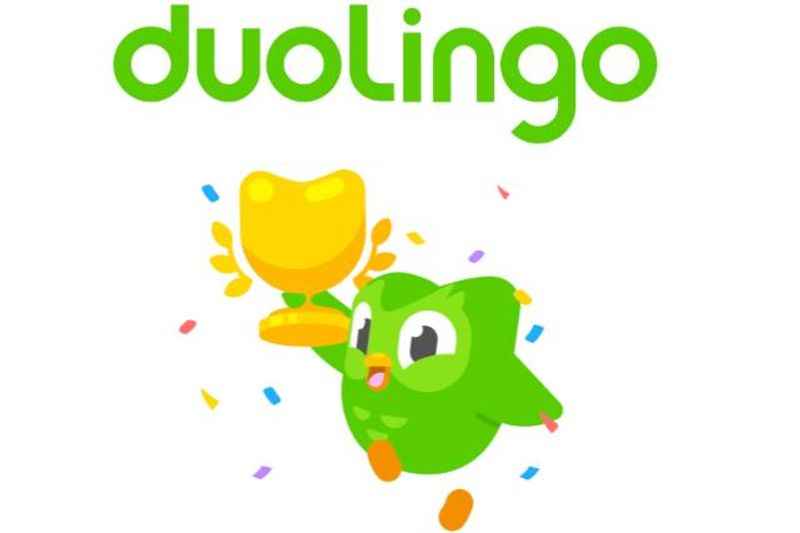
While using Duolingo to learn a new language, there are several complementary activities that can enhance your language learning journey and provide additional exposure to the target language.
If you are planning a vacation that requires some foreign language acquisition, it is a great idea to use these supplementary resources and language-learning techniques to ensure you can communicate on arrival.
Here are some things you can do alongside Duolingo to further immerse yourself in the language:
Listen to Podcasts : Explore podcasts in your target language that cover topics of interest. Listening to native speakers conversing will help you improve your listening comprehension and expose you to authentic language usage.
Watch Movies and TV Shows : Find movies, TV series, or documentaries in the language you're learning. Subtitles can be useful for comprehension, and gradually, you can challenge yourself by watching without subtitles.
Read Books and Articles : Expand your vocabulary and understanding of grammar by reading books, articles, or online content in your target language. Start with materials appropriate for your language level and gradually work your way up.
Engage in Language Exchange : Connect with native speakers through language exchange platforms or social media groups. Practice conversation skills by chatting with them or arranging video calls to have meaningful language exchanges.
Follow Social Media Accounts : Follow social media accounts of native speakers or influencers who share content in your target language. This exposes you to colloquial language, cultural references, and current trends.
Listen to Music : Discover music in your target language and explore various genres. Pay attention to the lyrics and try to understand their meaning. Singing along can also help improve pronunciation and intonation.
Join Online Language Communities : Participate in language learning forums, online groups, or language exchange apps to connect with other learners and native speakers. Engaging in discussions, asking questions, and sharing resources can provide additional support and motivation.
Practice with Language Learning Apps : Supplement your Duolingo practice with other language learning apps that offer different approaches and activities. This can provide a well-rounded learning experience and reinforce your language skills.
Remember, incorporating these activities alongside Duolingo will further expose you to the language, improve your comprehension, and enhance your overall language learning journey.
Embrace the opportunities to engage with native speakers and immerse yourself in the culture to gain a deeper understanding of the language beyond what Duolingo alone can offer.
FAQs Related to Our Duolingo Review
Let's look at some frequently asked questions relating to this Duolingo review.
When is the best time to start learning a new language?
The best time to start learning a language is whenever you feel motivated and ready to learn.
Whether you're a beginner or already have some knowledge, you can begin at any time and progress at your own pace with Duolingo's user-friendly approach.
Starting to learn languages at a younger age can provide advantages such as enhanced language acquisition skills and increased proficiency.
However, it is never too late to begin learning a language, as motivation and consistent practice are key factors in language learning success.
Can you really become fluent with Duolingo?
Duolingo can be a useful tool to build basic language skills and vocabulary, but achieving true fluency requires practice beyond the app. Fluency involves comprehension, speaking, and cultural understanding.
Supplementing Duolingo with immersion, conversation, and real-life practice is crucial for reaching a high level of fluency.
Should language learners supplement Duolingo with something else?
Supplementing Duolingo with other resources can be beneficial for language learners.
While Duolingo provides a solid foundation to learn a language, incorporating diverse language learning tools like books, podcasts, or language exchanges can enhance comprehension, expose learners to real-life scenarios, and deepen their understanding of the language.
How long does it take to start speaking your target language with the help of Duolingo?
The time it takes to start speaking your target language with the help of Duolingo varies depending on various factors, including the time and effort you invest, your prior language learning experience, and the complexity of the language itself.
Consistent practice and active engagement can accelerate progress and enable learners to start speaking basic sentences relatively quickly.
Remember that the language learning app alone will not have you speaking fluently - you need to seek opportunities to speak with natives.
Is there a Duolingo Facebook Page?
Yes, Duolingo has an active Facebook page where learners can connect with fellow language enthusiasts, share their experiences, and access additional resources.
The Duolingo Facebook page serves as a supportive community that fosters language learning discussions and provides updates on new features and content.
Summing up This Duolingo Review - Is That Green Owl As Great As They Say?
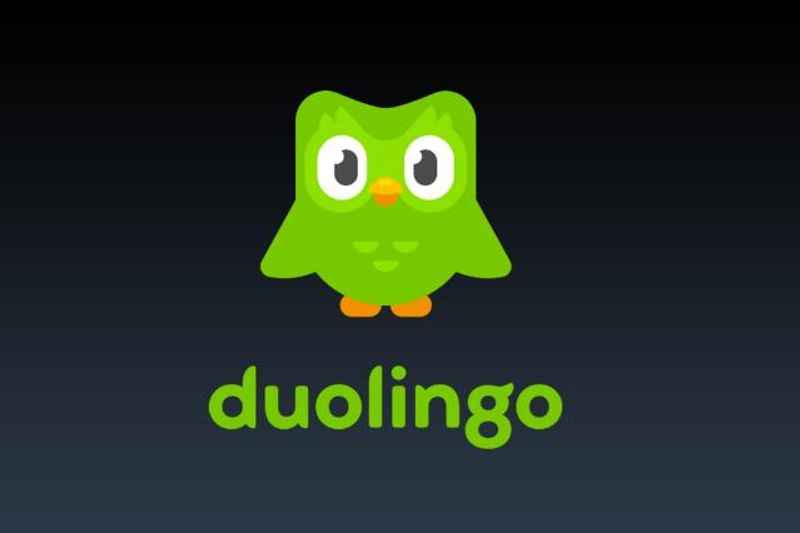
For those who are looking to dip their toe into the world of language learning, without committing more than fifteen minutes a day and spending absolutely nothing… Duolingo is most definitely the app for you.
With nearly forty possible languages to pick from, your options are faster than they have ever been, and it’s incredibly easy to get started, right from your computer or, as app users, directly to the palm of your hand.
By covering a variety of activities, on topics that focus on reading, writing, listening, and (at times) speaking, you can go from absolute beginner to speaking in full sentences, just after a couple of weeks of play.
Duolingo definitely helps with language fundamentals, but remember that fluency requires additional resources.
Immersion in the target language, conversing with native speakers, and exploring cultural aspects are vital for developing authentic fluency beyond what the app offers.
We hope this Duolingo review has been useful. Don't forget to share it with your friends and family members.
FEATURED IN


IMAGES
VIDEO
COMMENTS
The individual plan is pretty affordable and only costs around $7 a month. Compared to a lot of other language-learning apps, this is fairly affordable. That being said, if you have a few friends or family members who also want to learn a language, you can club together for a Duolingo Family plan. On this plan, you and up to five other people ...
Parecchio ('quite a lot' or 'quite a bit') Vi aspettiamo da parecchio tempo - We have been waiting for you for quite some time. Abbiamo bevuto parecchio! - We drank quite a bit! Piangeva parecchio - He was crying quite a lot. Abbiamo ballato parecchio in discoteca - We danced quite a lot at the club Un bel po' ('quite a lot')
With our free mobile app and web, everyone can Duolingo. Learn Italian with bite-size lessons based on science. Learn languages by playing a game. It's 100% free, fun, and scientifically proven to work. With our free mobile app and web, everyone can Duolingo. Learn Italian with bite-size lessons based on science. ...
10 surprising words we added to our travel vocabulary. by Sam Zabell. Before you visit a country where you don't speak the language, how do you prepare? Do you study the words for "hello," "goodbye," and "excuse me"? Or do you focus on places, like "bathroom" and "hotel"? Either way, there's no way to learn every single ...
Focus on what you do know. Instead of trying to speak in your new language exactly like you do in your own language, try to use only what you *do* know how to say. From a learning perspective, this helps you practice and build connections between the words and grammar you've already studied, but it's also really practical: There's only so much ...
(Where are you from?) Sono italiano, di Milano. (I am Italian, from Milan.) Roberto è spagnolo, di Madrid. (Robert is Spanish, from Madrid.) TIP: The Italian adjective straniero (foreign) can also be used as a noun (il straniero meaning "foreigner") For additional information, visit the DuoItalian page on Travel Phrases.
In December 2014, I downloaded Duolingo for the very first time, to learn Italian. I had never studied it before, so I started the Italian course from scratch and had a lot of fun with it for a good semester or two—until I got sidetracked with writing a dissertation about linguistics and language learning. 😅 In May 2022, shortly after buying flights to Italy for a family vacation, I ...
Italian lessons just got tough! I've been slowly learning Italian using Duolingo, finishing the first unit (of four) in about 100 days. I learned each lesson by writing out flash cards and practicing, getting up to legendary in each category. I learned about 6 verbs in unit 1. The first lesson set of unit 2 is "present 1", which has seven lessons.
The world's most popular way to learn Italian online. Learn Italian in just 5 minutes a day with our game-like lessons. Whether you're a beginner starting with the basics or looking to practice your reading, writing, and speaking, Duolingo is scientifically proven to work. Bite-sized Italian lessons. Fun, effective, and 100% free.
Duolingo also has a place to look up the words you do not know. And it's completely free. Have you heard of Duolingo? Most of us have started learning Italian online using Duolingo. If you haven't tried it yet, click here to see what I'm talking about (it's free too). But in this article, we won't talk about Duolingo's Italian course.
Possessive adjectives in both English and Italian change depending on who is the owner of the noun: We say my dog if I am the owner, her dog if a woman is the owner, our dog if we are the owner, etc. But there are some big differences learners need to know about these adjectives in Italian: They are nearly always used with a word for "the ...
6. Don't Buy Super Duolingo. Although Duolingo is currently trying to add more features that make Super Duolingo more enticing, I still don't think it's worth it for most users. In the past, once you made 5 mistakes, you either had to watch an ad or practice to get your "health" back so that you could keep learning.
The Italian course is one of the most popular language courses in Duolingo and at the time of writing (spring 2022) it sits in Duolingo's top six, with over 6.6 million users. Duolingo is a good tool to get you started in learning Italian but it is limited in a number of ways if you are looking to develop proficiency in the language.
Duolingo is the world's most popular way to learn a language. It's 100% free, fun and science-based. Practice online on duolingo.com or on the apps! Learn languages by playing a game. It's 100% free, fun, and scientifically proven to work. Duolingo is the world's most popular way to learn a language. ...
Summary. Duolingo Italian is an awesome tool that can take you places other platforms and apps can't. Even with its cons (from impractical sentences to gaps in grammar explanations) it's still one of the most useful tools out there for learning Italian. User friendliness - 9/10. 9/10. Delivers on promises - 8/10. 8/10. Authenticity - 8/10.
The basic goal is to work through the tree by completing every lesson… in every level… in every unit… in every section. As of April 2023, Duolingo's Italian course has a total of 51 units, spread across 4 different sections. As you move through the path, you'll get opportunities to complete some timed challenges by tapping on the ...
Do you want to learn a new language for free, fun and science-based? Duolingo is the world's most popular language learning platform, with courses in over 40 languages, interactive exercises, and a supportive community. Whether you want to practice online, on your phone, or with a podcast, Duolingo has something for you. Join millions of learners today and discover how Duolingo can help you ...
Duolingo is designed to teach you how to actually understand the language, not just memorize key phrases. Im late but the memrise italian course is more travel oriented. I just started using duolingo in hopes of trying to prepare for a future trip so I can have the basics down to converse in Italy. I selected my….
Italian speakers said that I seemed to improve rapidly during the three weeks (from duolingo you end up kind of knowing certain grammatical principles, but actually applying them in conversation takes practice). Of course the irony is always that the worse you do, the more likely people are to say (in English) "oh, you speak a good Italian".
6 posts. I haven't used Duolingo for Italian, but I did use Wesleyan University's free Italian for beginners course. It helped a lot and enabled me to speak to Italians. Another good resource is Coffee Break Italian. The podcast is excellent and allows you to practice and build your abilities gradually. Posted by Les OP.
Here are 3 ways to make gamification work for you: Hoard gems before you travel. You can take advantage of Duolingo's gem economy to buy yourself some leeway for when you're on the road. By foregoing a few timer boosts or Streak Freezes before your trip, you can use those gems to freeze your streak during the trip when you might not otherwise ...
On the other hand, due to being an app, Duolingo's ability to teach conversational Italian is very limited. Exercise from Duolingo Level 3. A scientific study found that the language proficiency gained by completing seven units of the French or Spanish courses in Duolingo was equivalent to four semesters of University study for reading and listening skills.
Duolingo Review: Quick Pros and Cons. Surely you first want to know about the pros and cons of this app. Pros: A smooth, easy-to-use interface that's manageable for tech newbies. Continuous motivational features including your daily streak, the life system, XP, badges, and in-game currency.